King Charles and Queen Camilla's coronation: All the best moments and photos
King Charles and Queen Camilla have been crowned! Start scrolling as HELLO! brings you all the very best pictures, videos and stories from the coronation.
World leaders, celebrities and royals arrive at Westminster Abbey
The Prince and Princess of Wales wave at crowds during procession
Princess Anne's warm greeting to Prince Harry at coronation service
Watch: King Charles coronation in 60 seconds
All the best fashion moments from the day
Watch the historic moment King Charles III is crowned
Intimate balcony moment revealed
Getty's royal photographer Chris Jackson captured these incredible behind-the-scenes snaps of the King and Queen as they waved to the crowds from the Buckingham Palace balcony.
MUST-SEE: King Charles' coronation – key details you may have missed
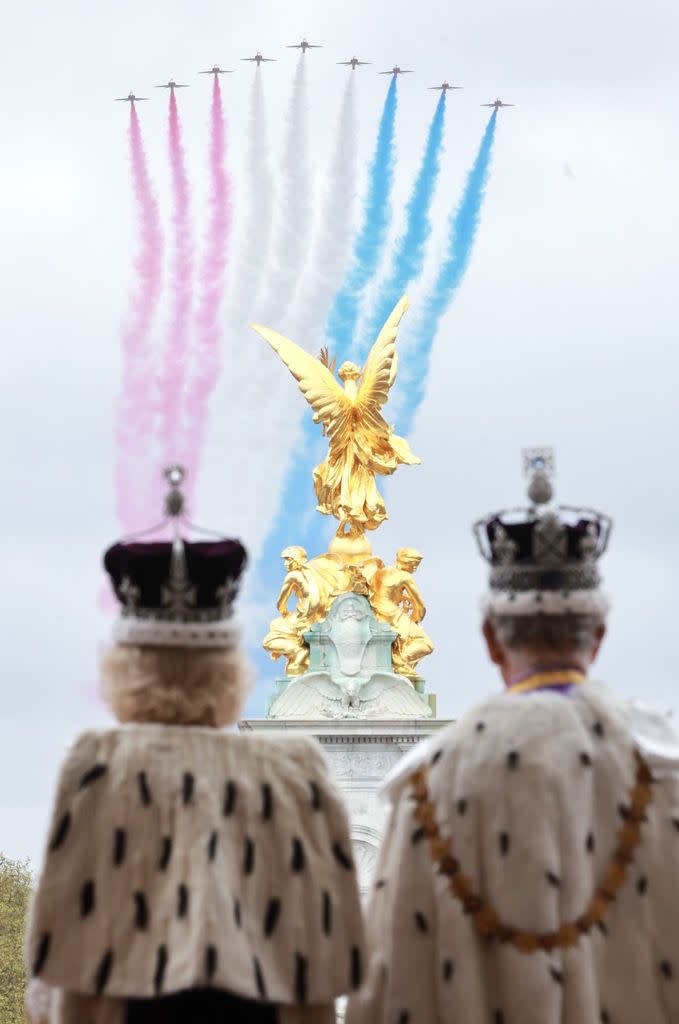
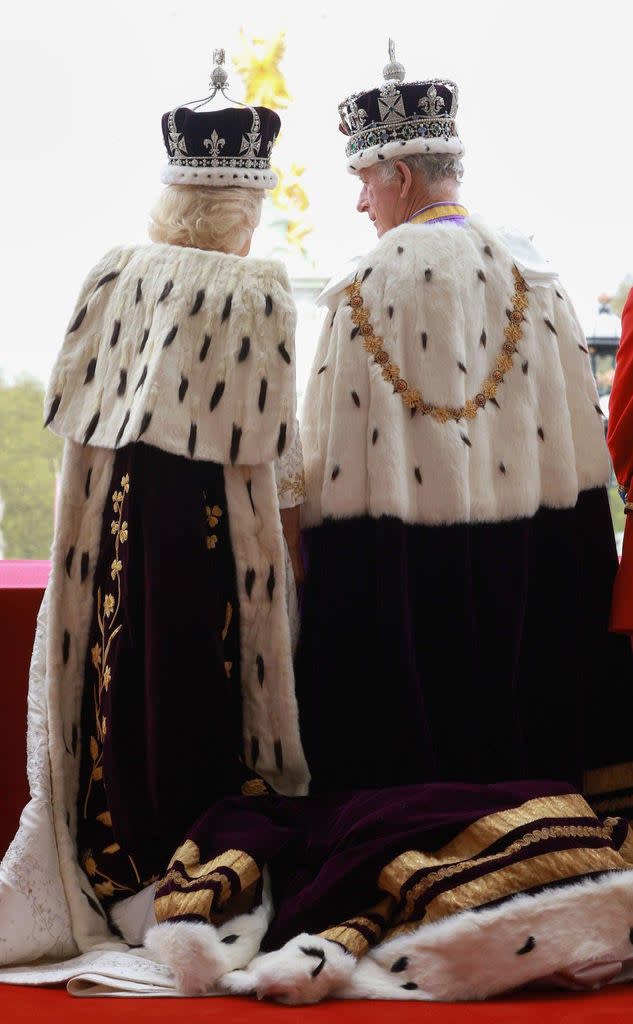
The balcony appearance and flypast
The new King and Queen appeared on the balcony of Buckingham Palace at 2.25pm. They were joined by their attendants, and working members of the royal family, including the Prince and Princess of Wales. The Duke and Duchess of Edinburgh and their children, and Princess Anne were also there.
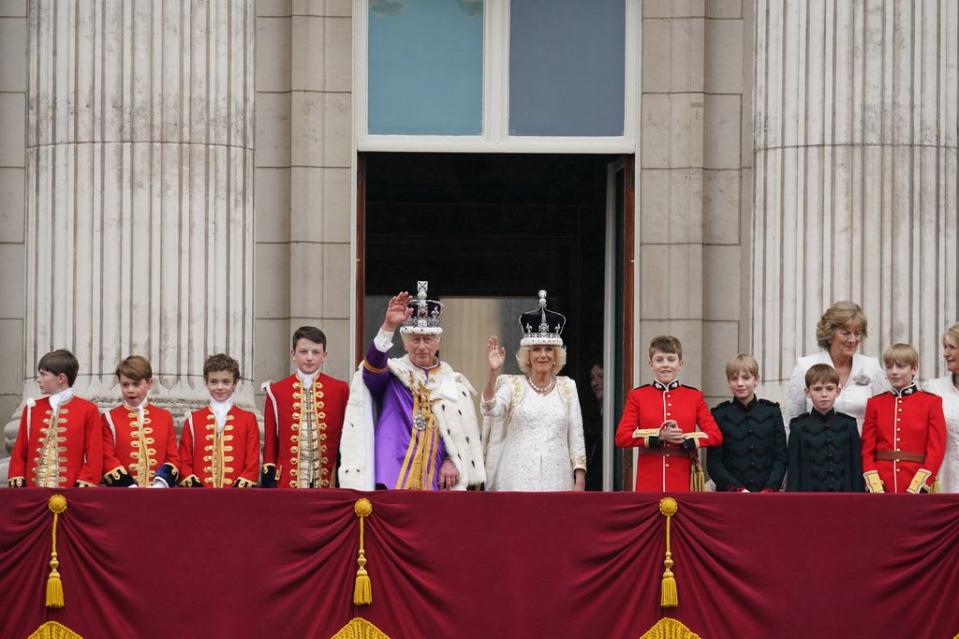
The flypast to mark the King’s coronation had to be scaled down due to unsuitable weather conditions. More than 60 aircraft from the Royal Navy, British Army and Royal Air Force had been due to take part. However, the event only involved helicopters and the Red Arrows aerobatic display team.
See the newly-crowned King and Queen watch the flypast
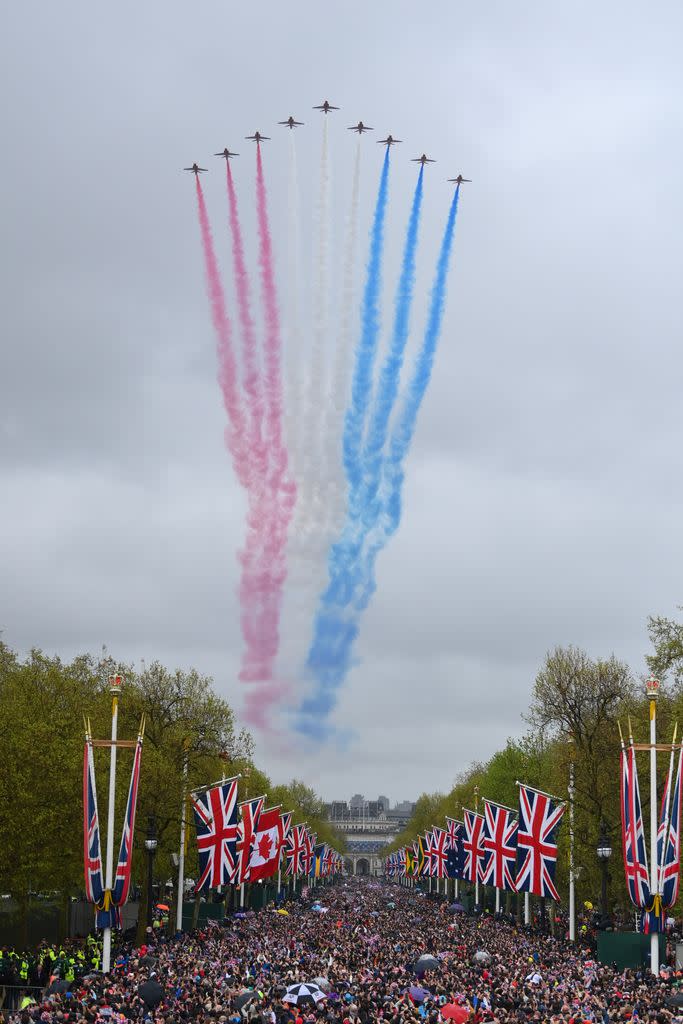
It was, nevertheless, a spectacular sight.

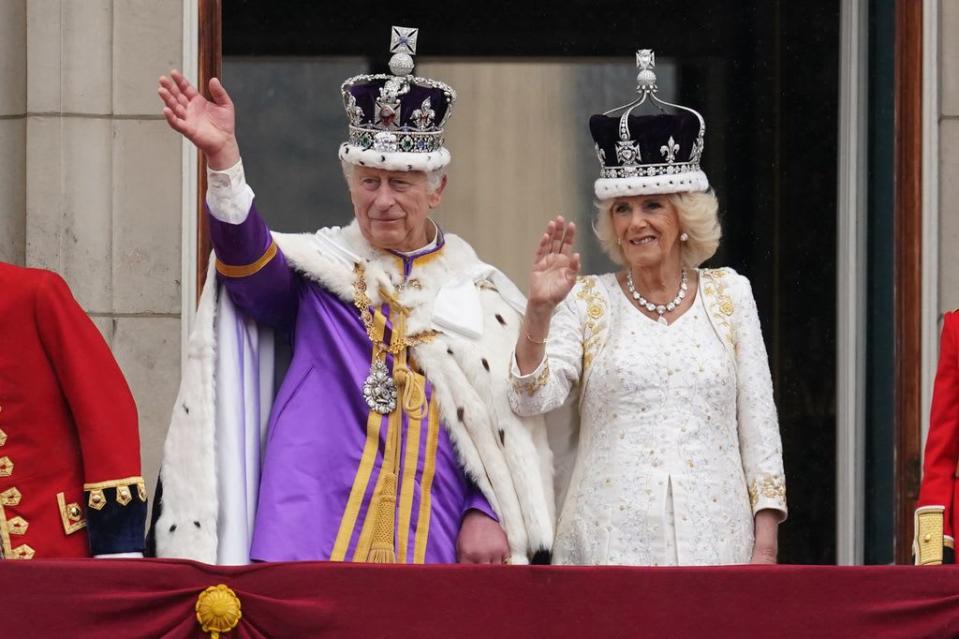
As he prepared to return inside the Palace, King Charles paused to wave at the huge crowd that had gathered on The Mall.
And in a final, emotional tribute, God Save The King rang out from the throng, who had braved downpours to celebrate their new monarch.

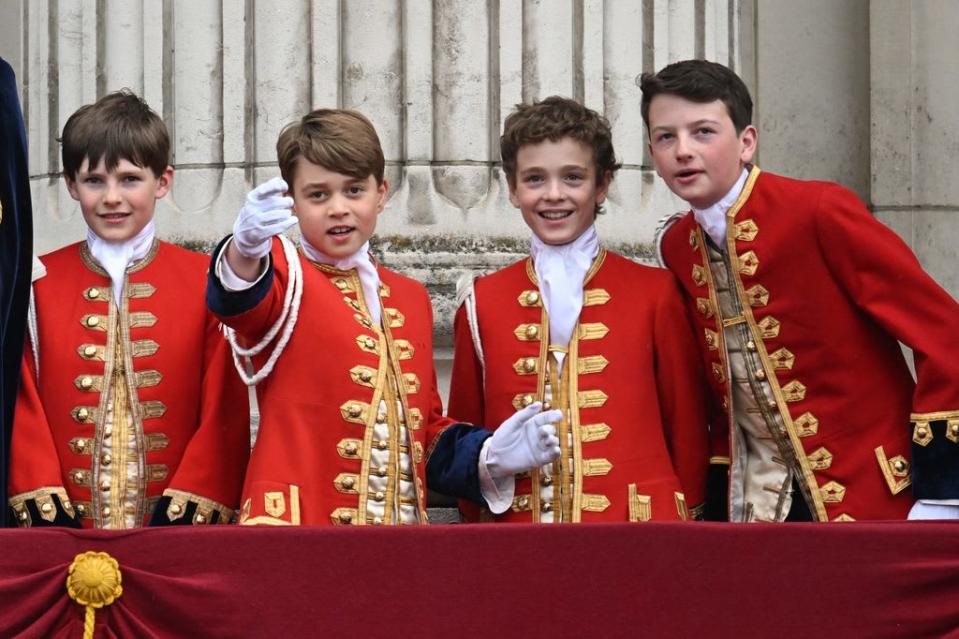


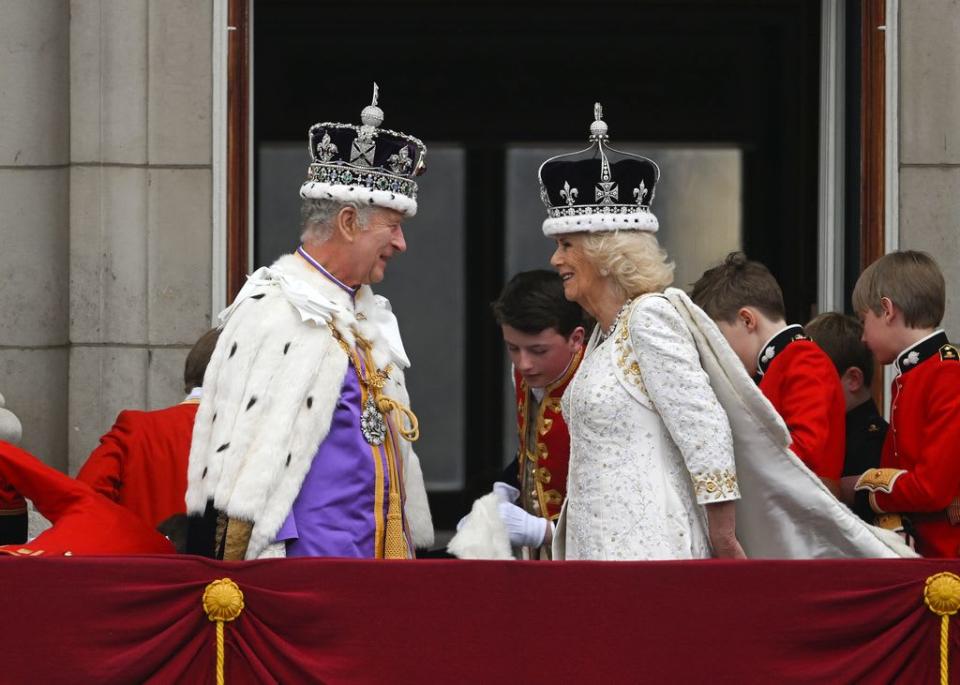
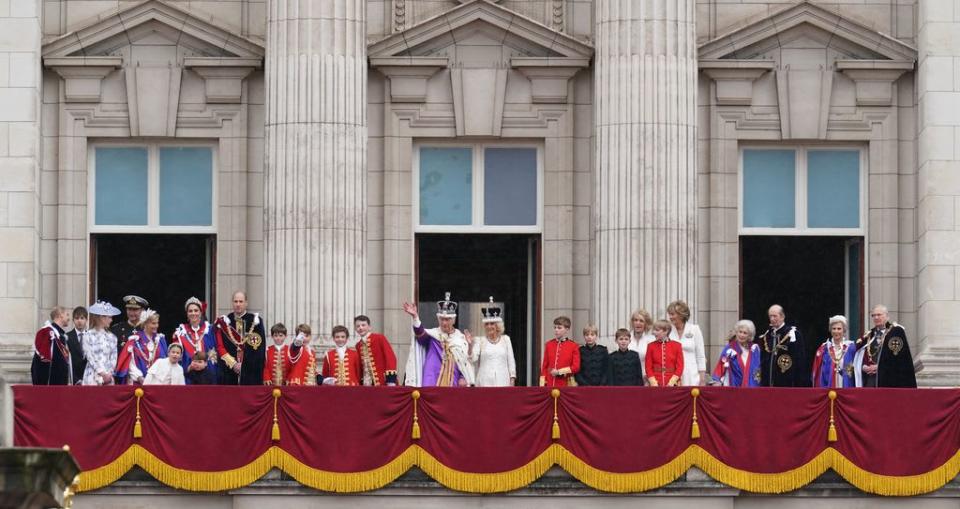
The procession to Buckingham Palace
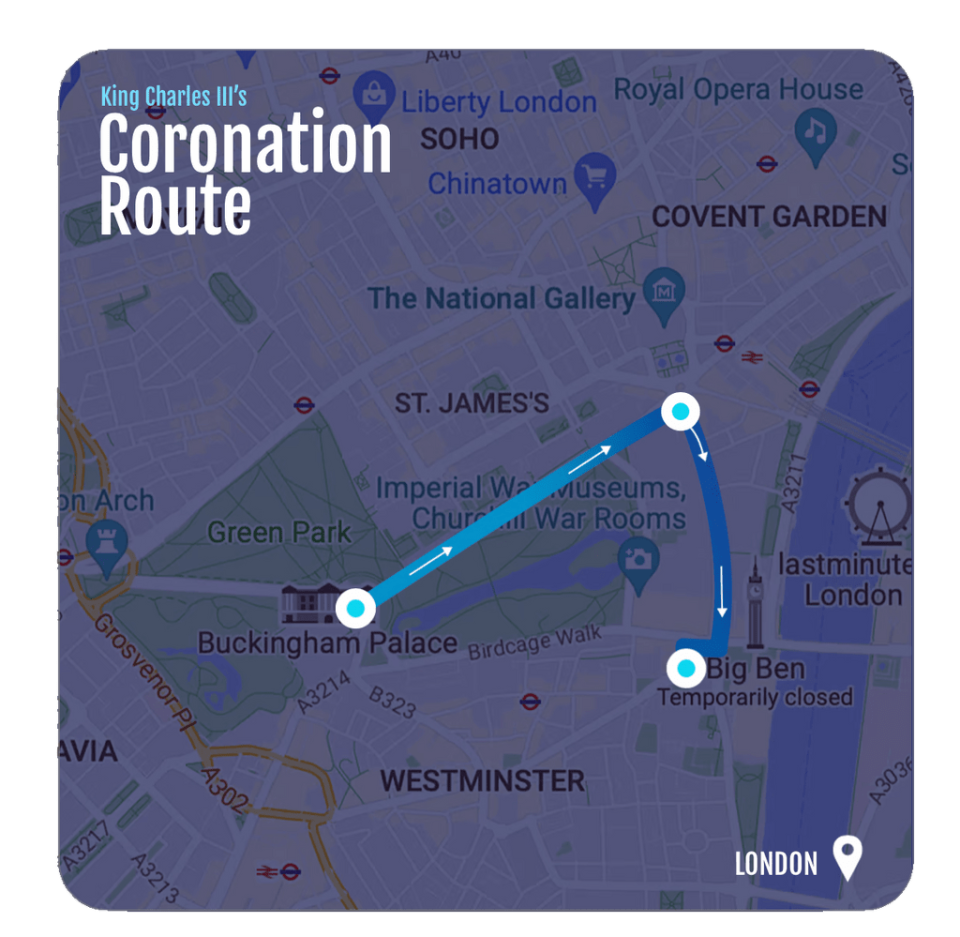
King Charles and Queen Camilla left Westminster Abbey as the bells rang out. They are travelling in the Gold State Coach.
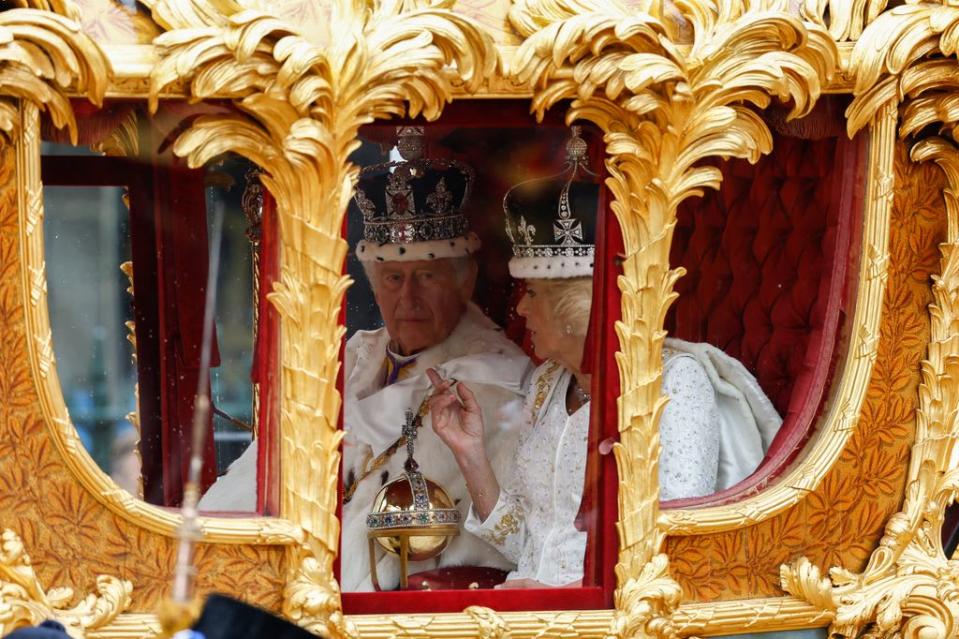
Only the monarch and their spouse are allowed to travel in this carriage, which is over 260 years old and has been used at every coronation since that of William IV in 1831. It weighs four tonnes and requires eight horses to pull it.
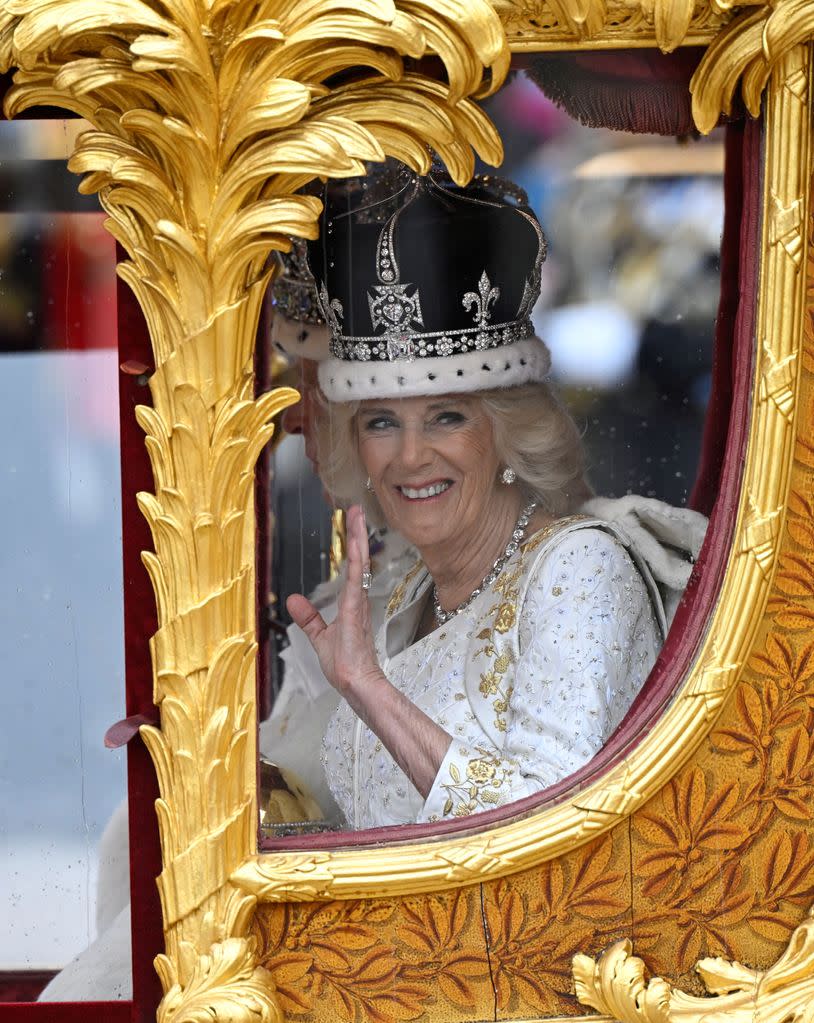
Travelling behind were Prince William and Princess Kate, with their three children, Prince George, Princess Charlotte and Prince Louis. They sat together in a black and gold carriage pulled by four horses.
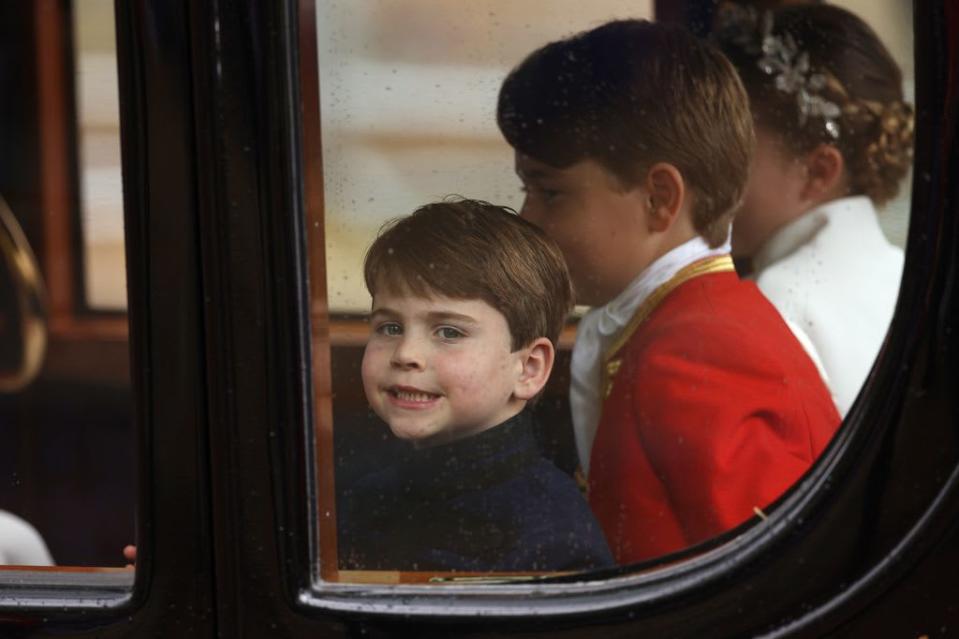
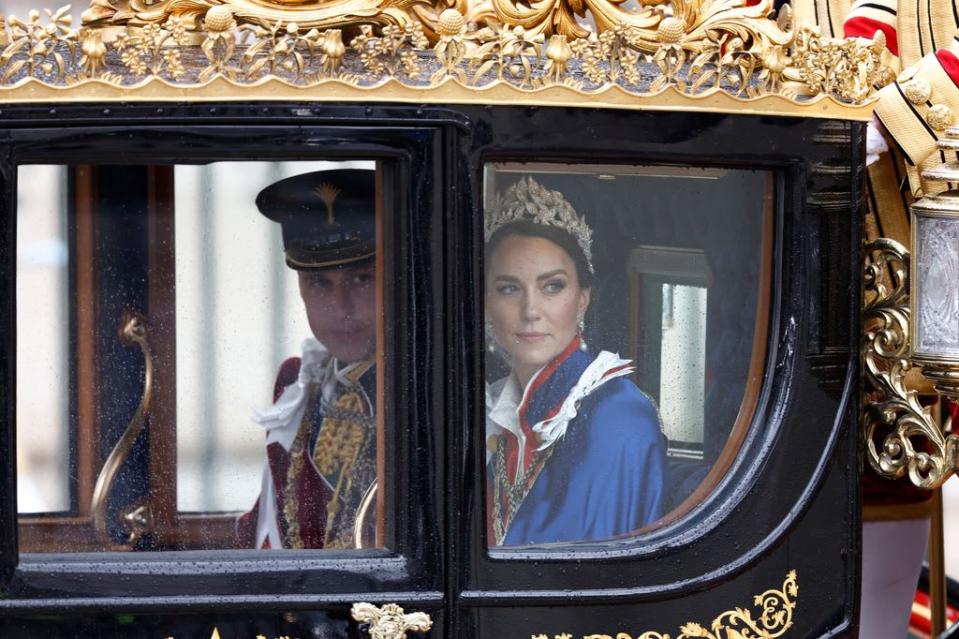
Travelling in a similar carriage in the procession were Prince Edward, wife Sophie and their children, Lady Louise and James Earl of Wessex.

Princess Anne, meanwhile, rode on horseback behind the King and Queen, leading 6,000 armed services personnel through the streets of London.
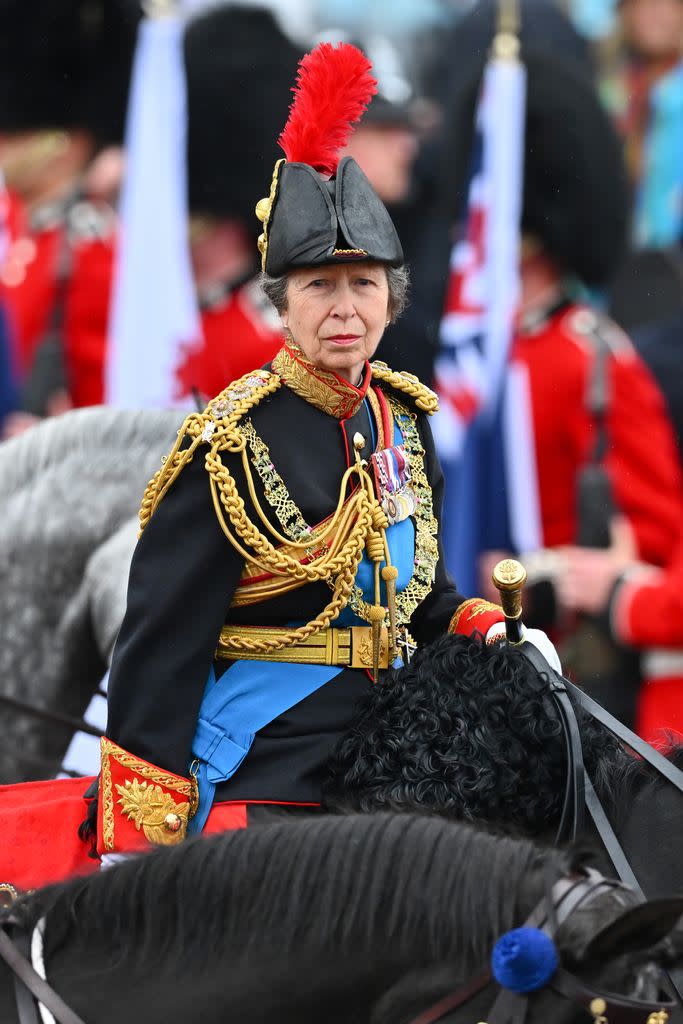
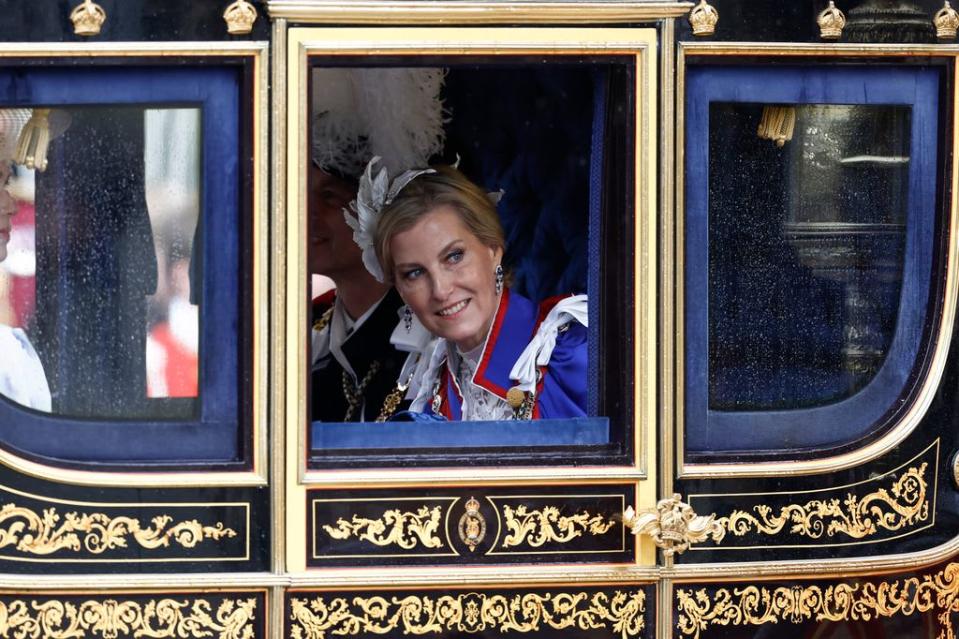
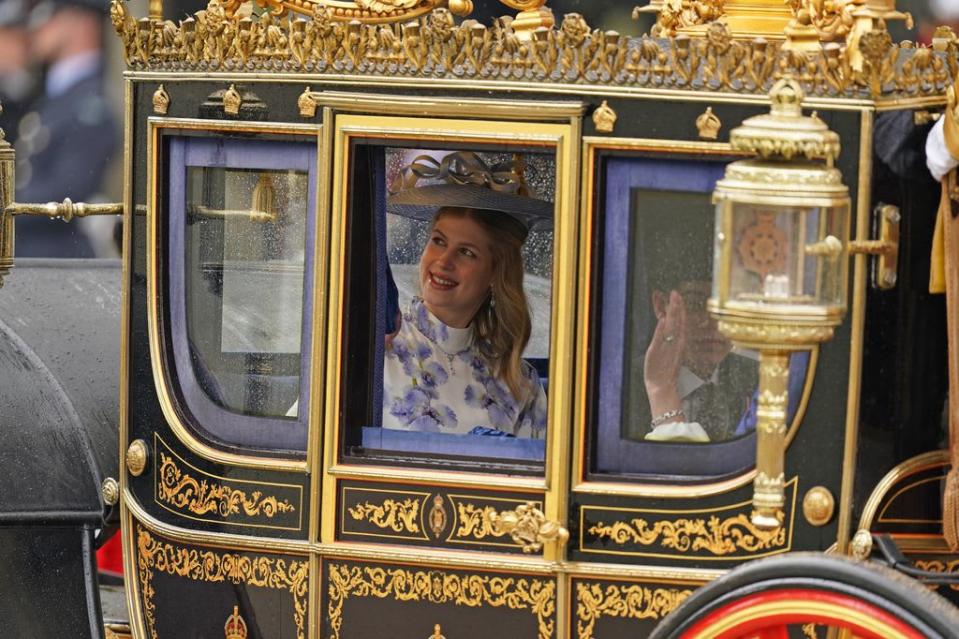
She is acting as Charles' Gold-Stick-in-Waiting, who is entrusted with the monarch's personal safety.
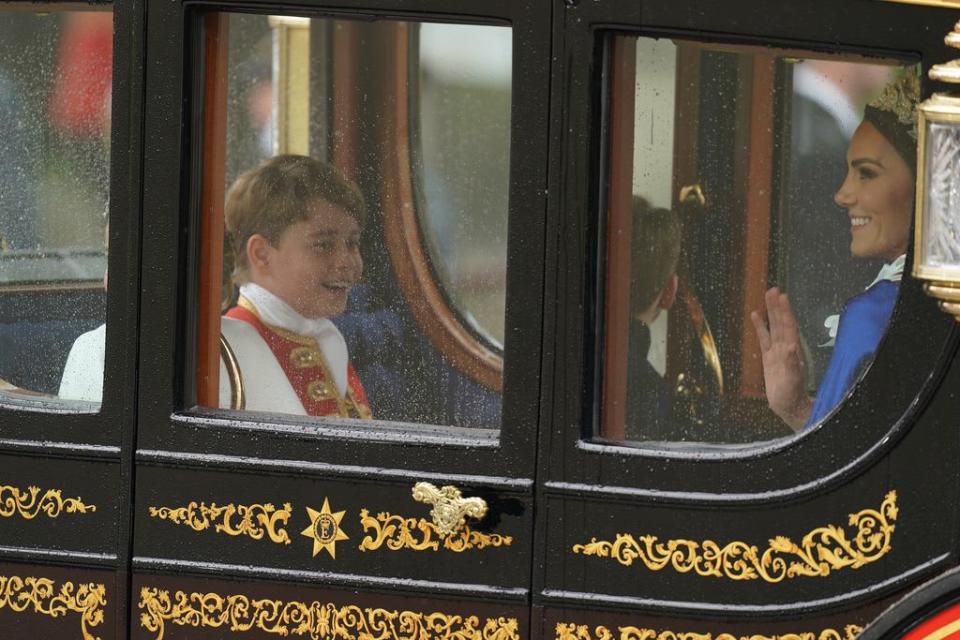
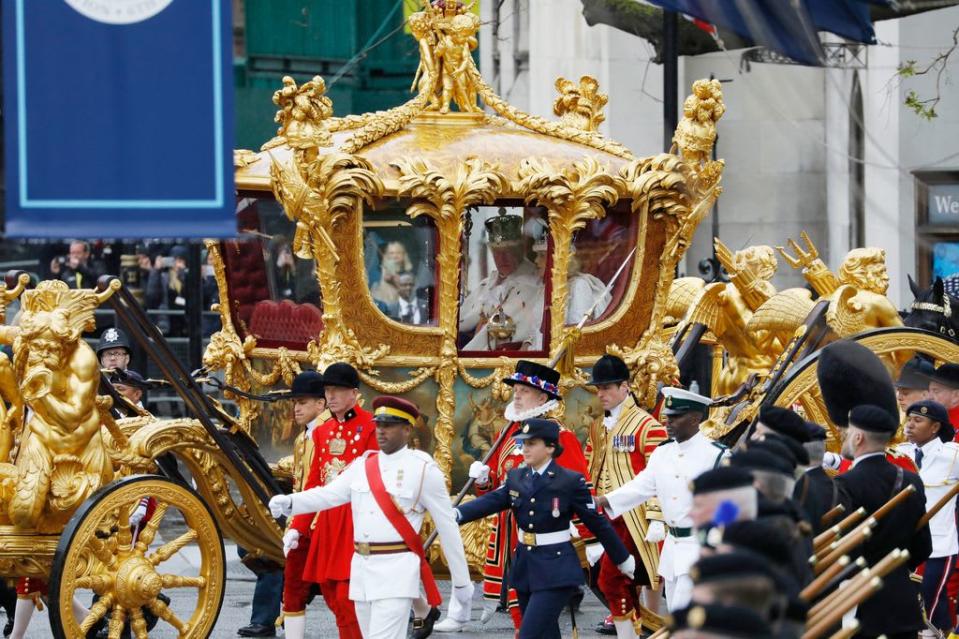
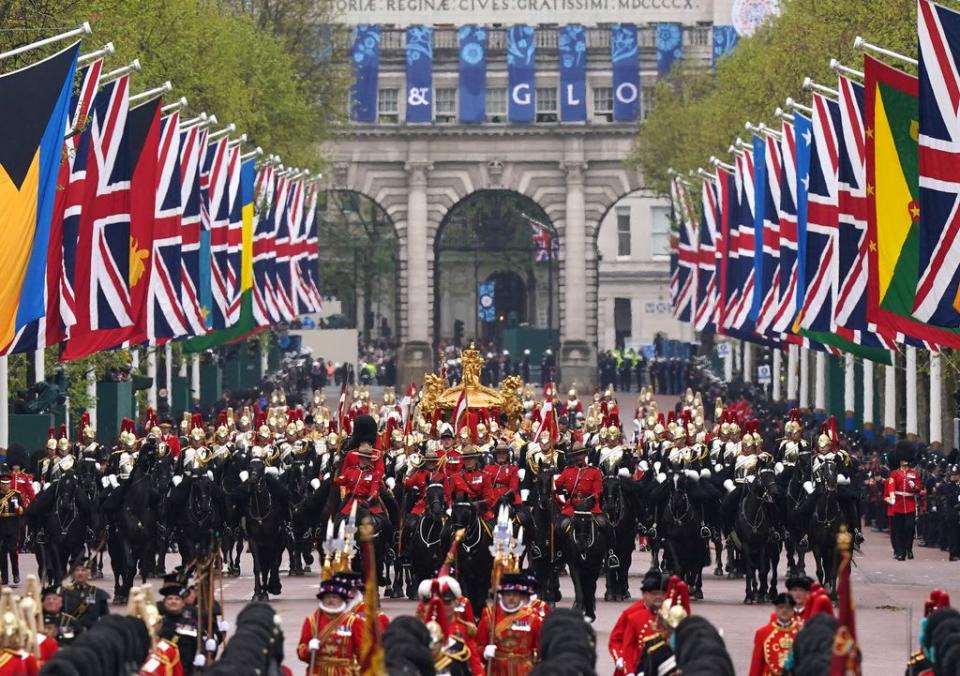
In the video below, watch HELLO! reporter Isabelle Casey discuss the exciting carriage moment with popular American royal style expert Elizabeth Holmes, who collaborated with HELLO! for coronation weekend.
On The Mall, cheers of "God Save the King" and "hip hip hooray" rang out as the carriage returned to Buckingham Palace.
The departure
The King, carrying the scepte and orb, emerged to the sounds of 'God Save The King'. Princess Kate and Princess Charlotte curtseyed as he past by, with Prince George again helping to carry his grandfather's heavy robe.
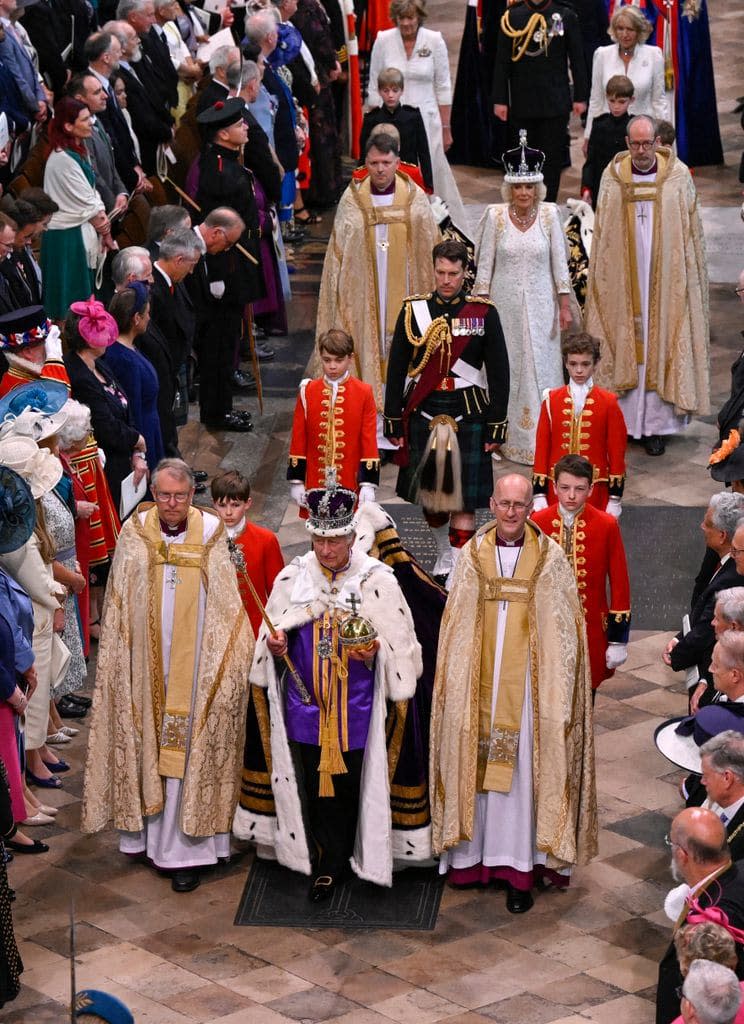
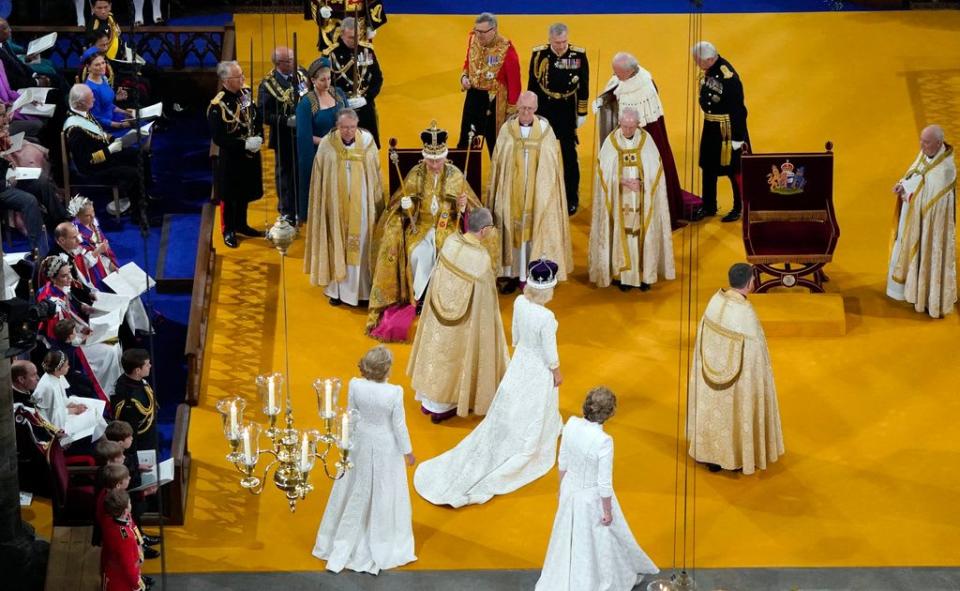
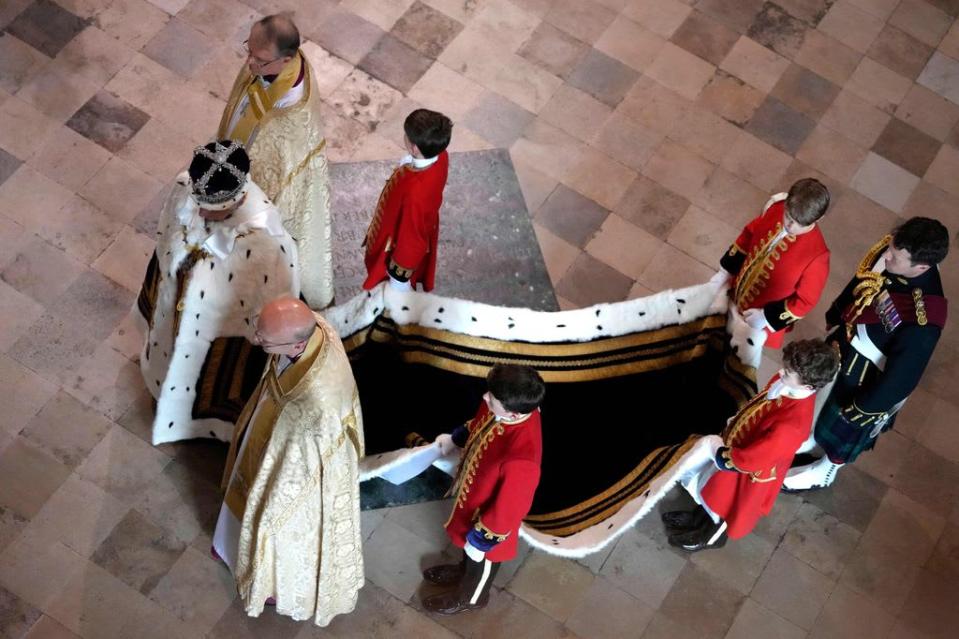
Charles is now wearing the Imperial State Crown. The Imperial State Crown weighs more than 1kg and is adorned with 2,901 precious stones, including the Cullinan II diamond – making it very heavy! Queen Elizabeth II traditionally wore the headpiece for the State Opening of Parliament, as well as at her 1953 coronation.
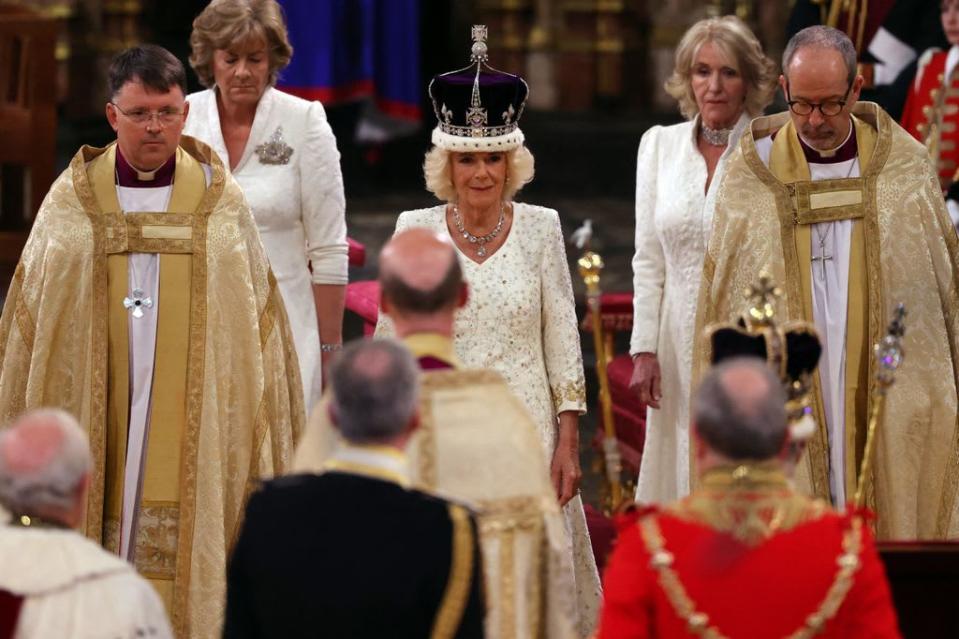
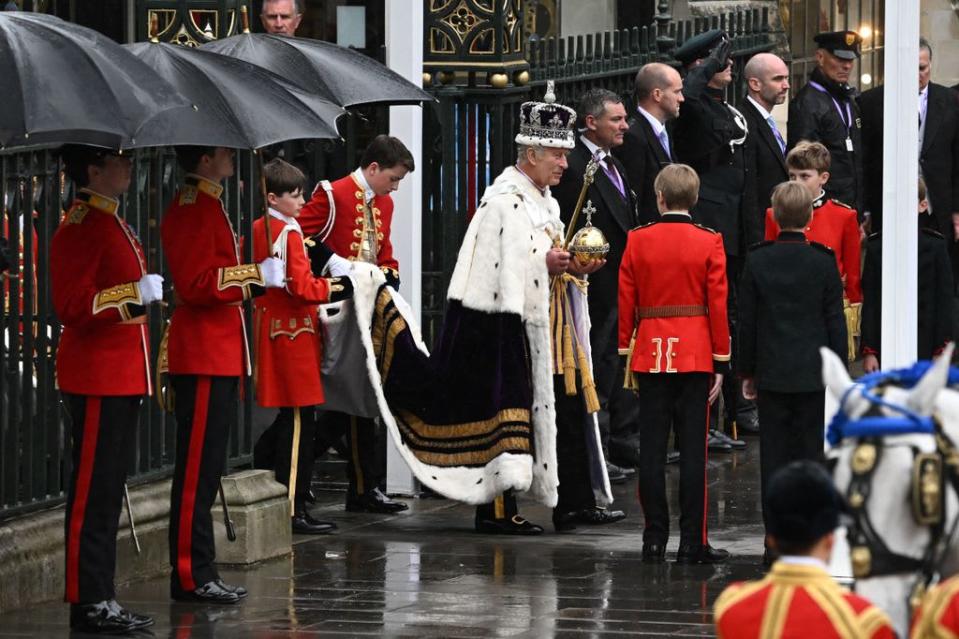
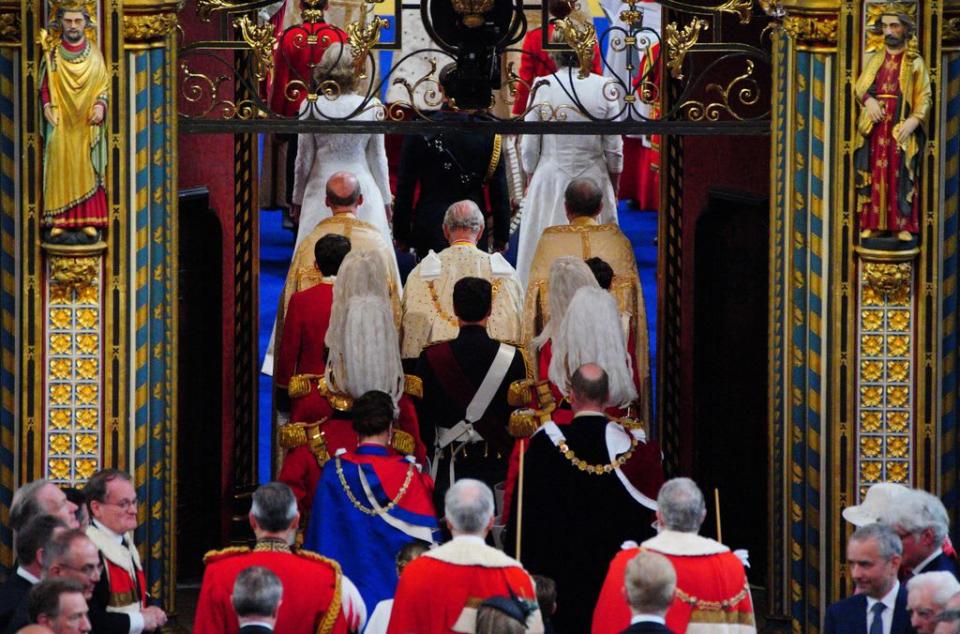
The King was followed in by his wife, Queen Camilla, who was attended by her Pages of Honour. She is still wearing the Queen Mary crown.
The royal family processed behind as the Gold State Coach pulled up outside Westminster Abbey.
St Edward's Chapel
As the choir sang out, the King and Queen departed their thrones and entered St Edward's Chapel, which is located behind the High Altar.
The royals changed into their purple Robes of Estate, with the King putting on the Imperial State Crown. They prepared for the Coronation Procession, which will take them back to Buckingham Palace.
The communion
The King and Queen removed their crowns for the latter part of the service. Together, they took Holy Communion, the principal act of worship for the Christian church.

The investiture
The investiture is the crowning moment of the coronation. The King was given a shimmering golden coat to wear - called the Supertunica -before sitting back in the Coronation Chair as regalia was presented to him. The chair - also known as St Edward's Chair - is believed to be the oldest piece of furniture in the UK still used for its original purpose. A total of 26 monarchs have been crowned in it.
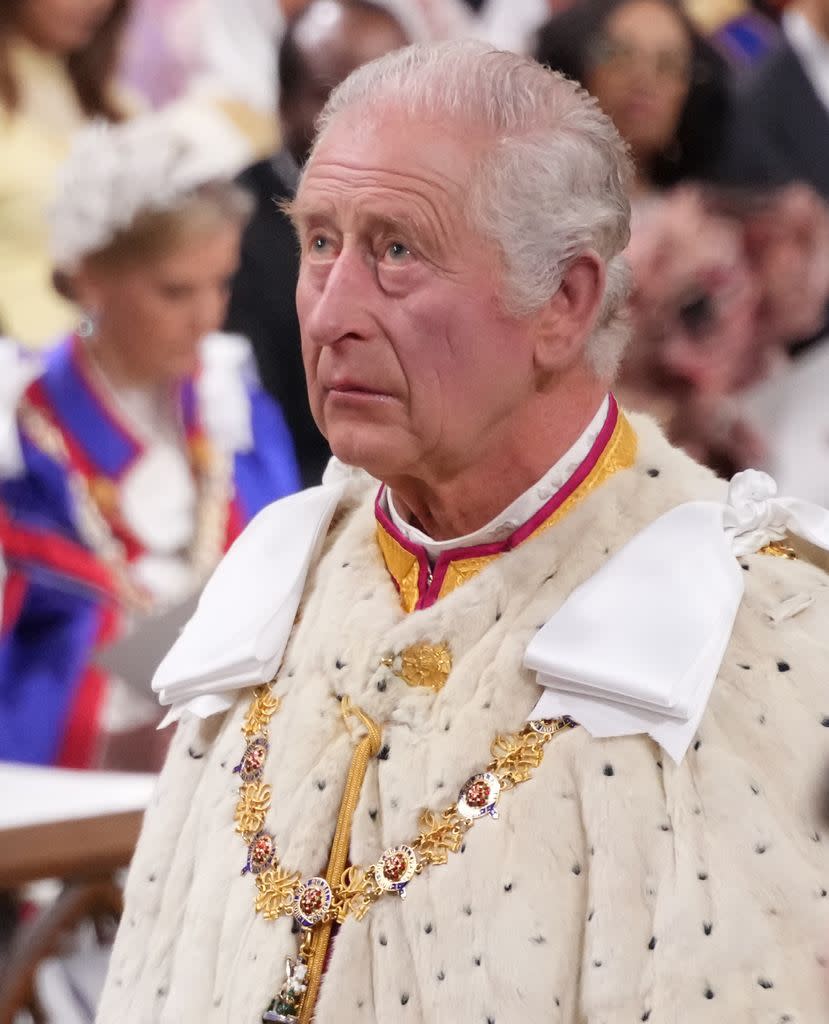
Among the regalia was the Jewelled Sword. The Archbishop of Canterbury told Charles to use it to "do justice, stop the growth of iniquity, protect the holy Church of God and all people of goodwill".
The Robe Royal was presented by Baroness Merron, who was representing the Jewish community, and the Orb, representing the sovereign's power, was handed over by the Archbishop of Armagh.
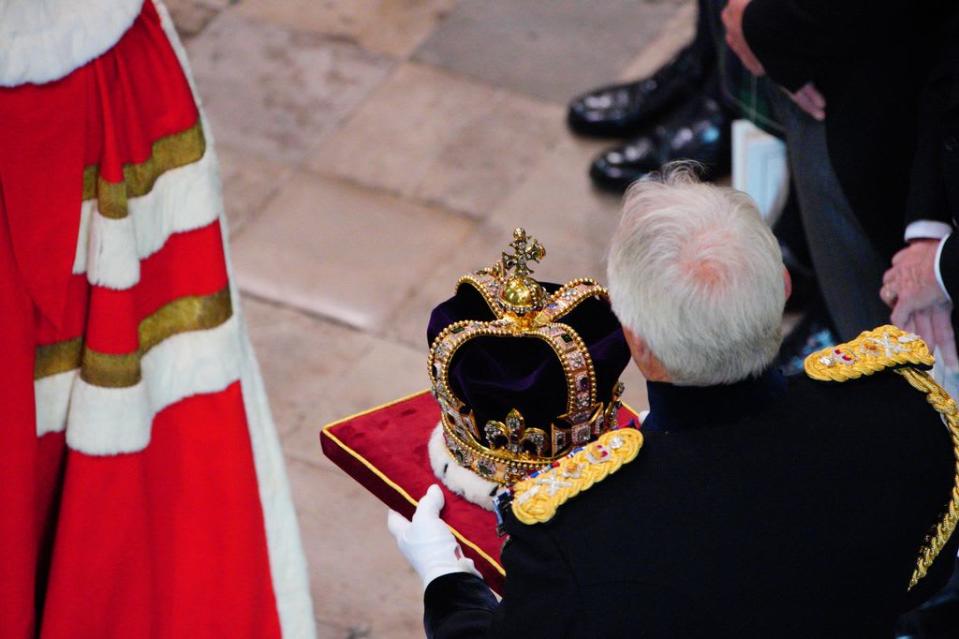
The King was then presented with the St Edward's Crown, which was placed on his head by the Archbishop. It will be the only time in his life that Charles will wear the 360-year-old crown, which is made of solid 22-carat gold, is over 30cm (1ft) tall and weighs around 2.23kg (nearly 5lbs).
The congregation then proclaimed, "God Save the King! as the Abbey bells rang, trumpets sounded, and gun salutes were fired across the UK.
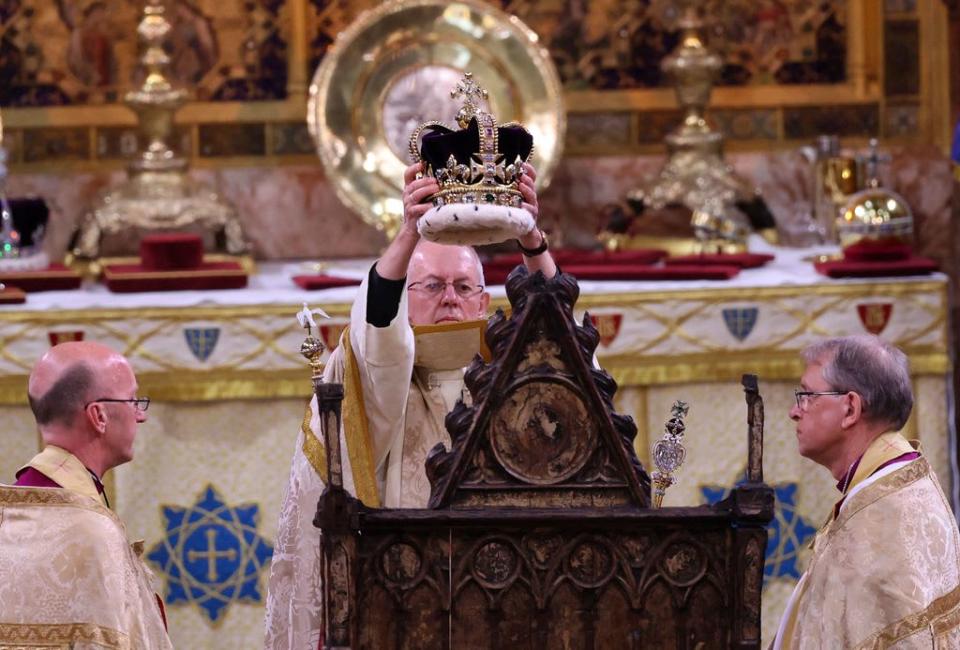
The archbishop then knelt before the monarch before pledging his faith to Charles III.
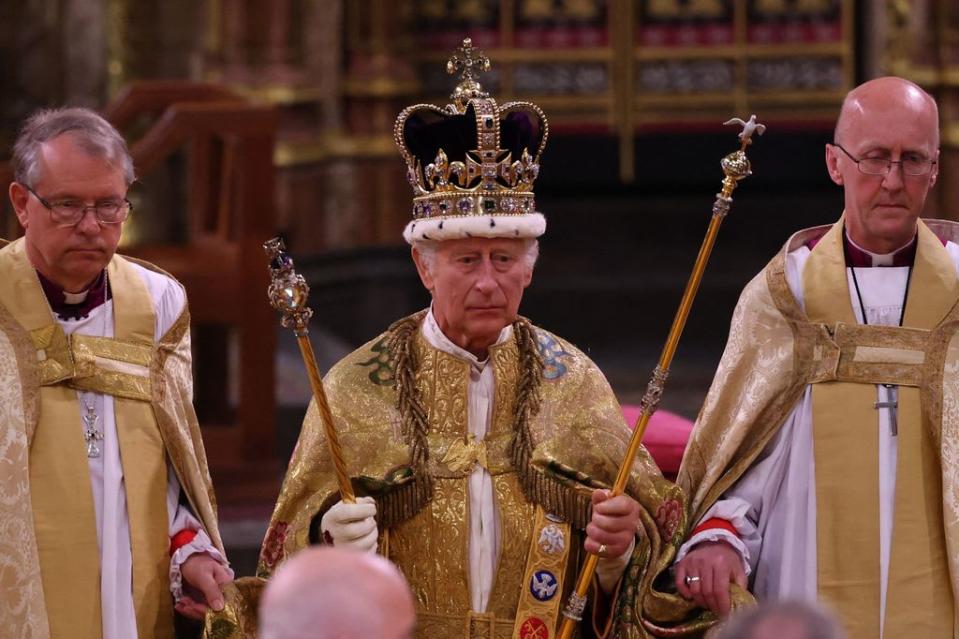
In an especially moving moment, Prince William then knelt before his father, placed his hands between the hands of the King and said: "I, William, Prince of Wales, pledge my loyalty to you and faith and truth I will bear unto you, as your liege man of life and limb. So help me God."
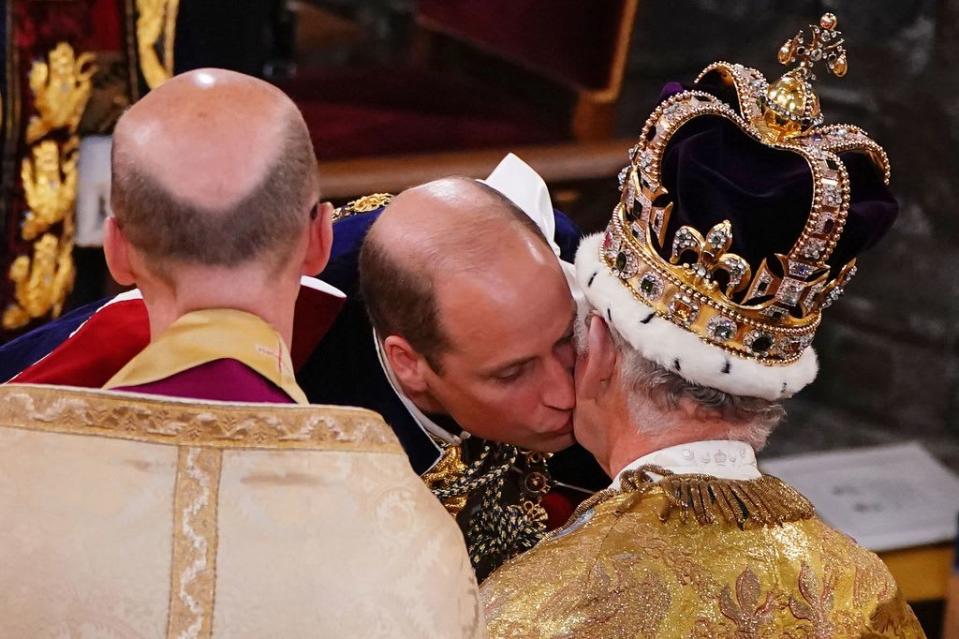
He then kissed the King on the cheek with Charles looking visible emotional.
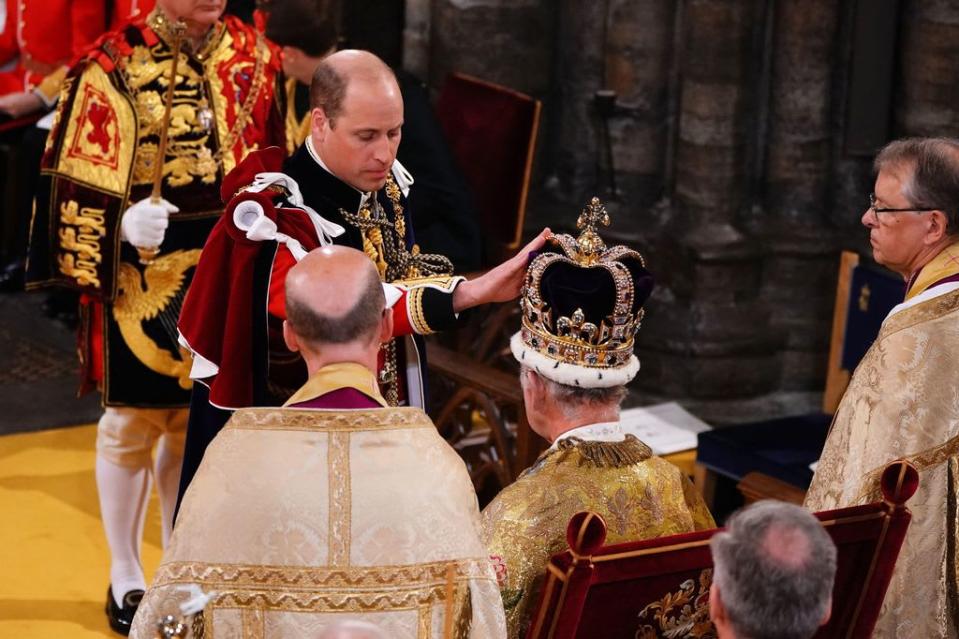
The Prince of Wales' words — called the Homage of Royal Blood — echoed the vow made by his late grandfather Prince Philip to his wife Queen Elizabeth in 1953 when he also vowed to be her "liege man of life and limb."

Queen Consort Camilla was then anointed and crowned, albeit in a simpler ceremony and she was not required to take an oath. She was crowned with Queen Mary's Crown.
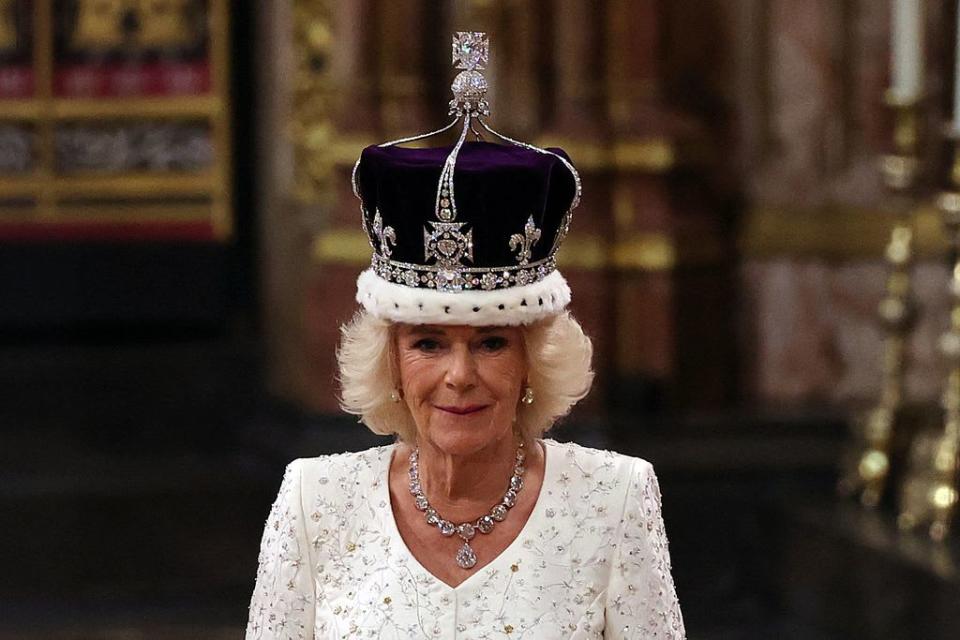
The anointing
The sermon was preached by the Archbishop and began, "We are here to crown a king, and we crown a king to serve". This was followed by the ancient hymn Veni Creator Spiritus, which was sung in languages from across the United Kingdom, and called on the Holy Spirit. Then came the most sacred part of the coronation rite: the anointing with holy oil that marks the King as chosen and set apart by God.
A screen then shielded the King from view as his ceremonial robe was removed and he took his seat in the ancient coronation chair, which was placed on the Cosmati Pavement facing the High Altar. During the anointing, the Choir sang Handel’s famous anthem, Zadok the Priest, which draws on words from 1 Kings 1 and was composed for the coronation of George II in 1727. It has been used at every coronation since.
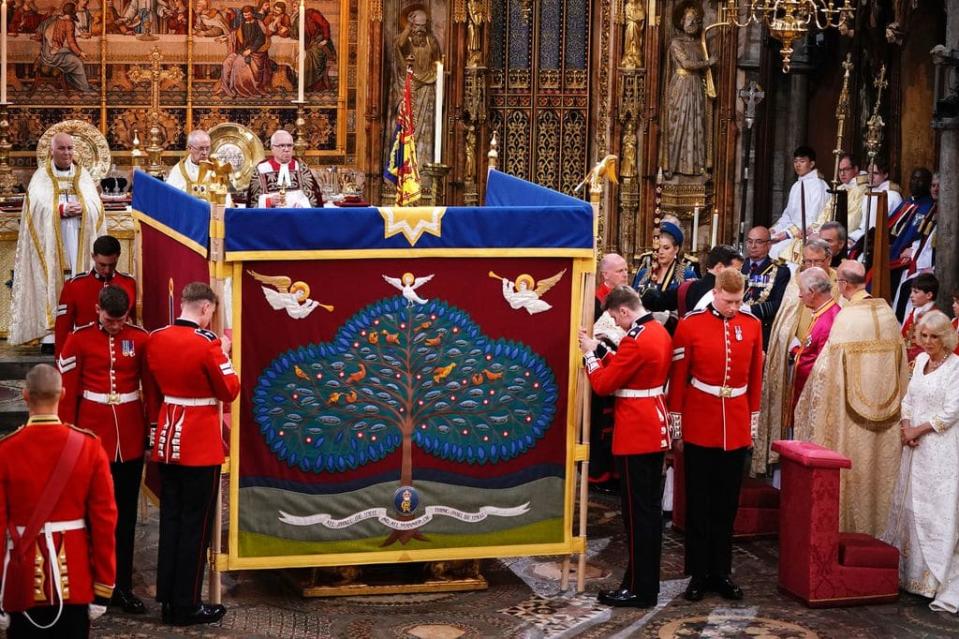
Once anointed, the King was vested in priestly garments in white and gold that symbolise both humility and splendour.
For the annointment, the archbishop poured special oil from the Ampulla - a gold flask - on to the Coronation Spoon before anointing the King in the form of a cross on his head, breast and hands.
The Anointing

Cited as the most sacred part of the coronation ceremony, the anointing is carried out by the Archbishop of Canterbury. He will use the golden eagle-shaped ampulla and the 12th-century silver-gilt anointing spoon to anoint the King in the form of a cross.Charles' chrism oil was made sacred in Jerusalem's Church of the Holy Sepulchre. The oil was declared by the Patriarch of Jerusalem, His Beatitude Patriarch Theophilos III, and the Anglican Archbishop in Jerusalem, The Most Reverend Hosam Naoum.It's based on the same recipe used for Queen Elizabeth II and contains notes of rose, jasmine, cinnamon, orange blossom, sesame, benzoin and amber.
The coronation ceremony begins
The King and Queen took their seats before the high altar of the Abbey at 11am. Archbishop of Canterbury Justin Welby then gave the opening address before Charles stood before the altar.
He was proclaimed the “undoubted King” before the congregation were asked to show their homage and service by shouting "God Save the King!” This first stage - the recognition - which sees Charles presented to "the people" is a tradition dating back to Anglo-Saxon times.
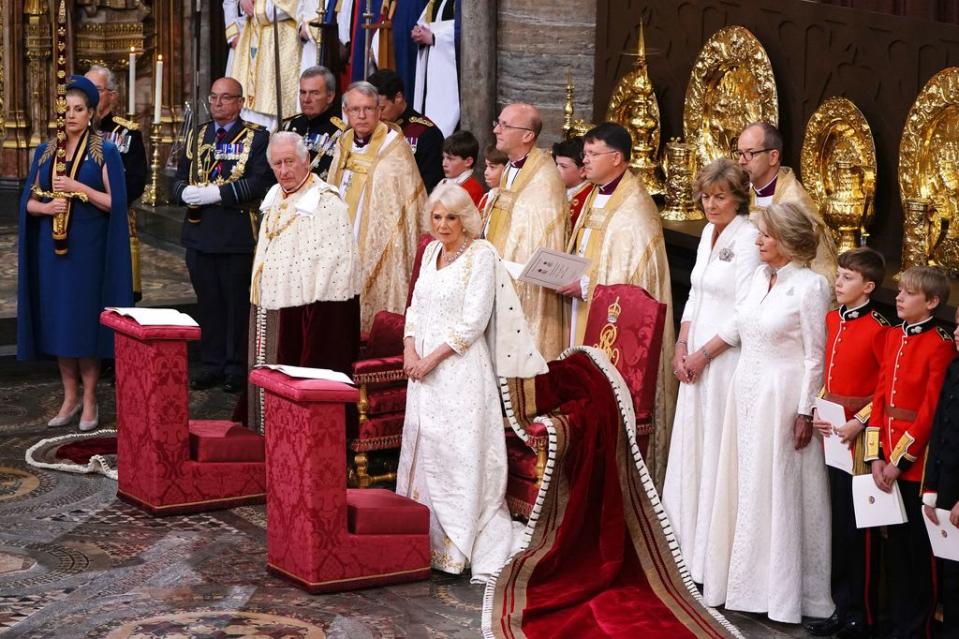

Charles was then given a Bible to swear an oath confirming that he will uphold the law and the Church of England during his reign. He knelt and closed his eyes as he listened to the oath before responding: "All this I promise to do." He subsequently bent his head and kissed the Bible before making a taking a second oath - the Accession Declaration Oath - stating that he is a "faithful Protestant".
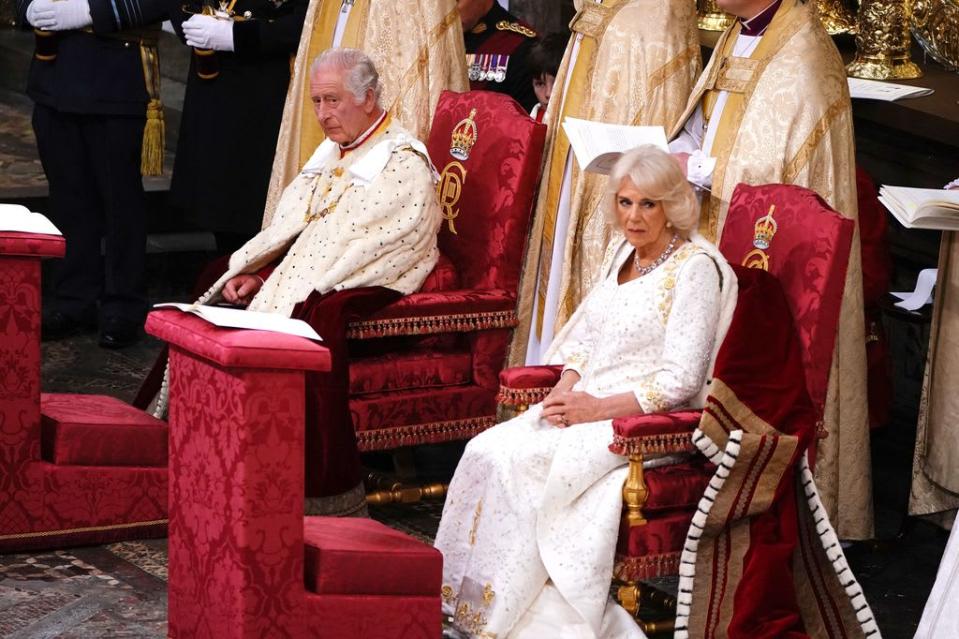
The King and Queen arrive
At 10:53, Queen Camilla and King Charles arrived at the Abbey. They were joined by their Pages of Honour, including Prince George who wore a military uniform and helped carry his grandfather's robes.
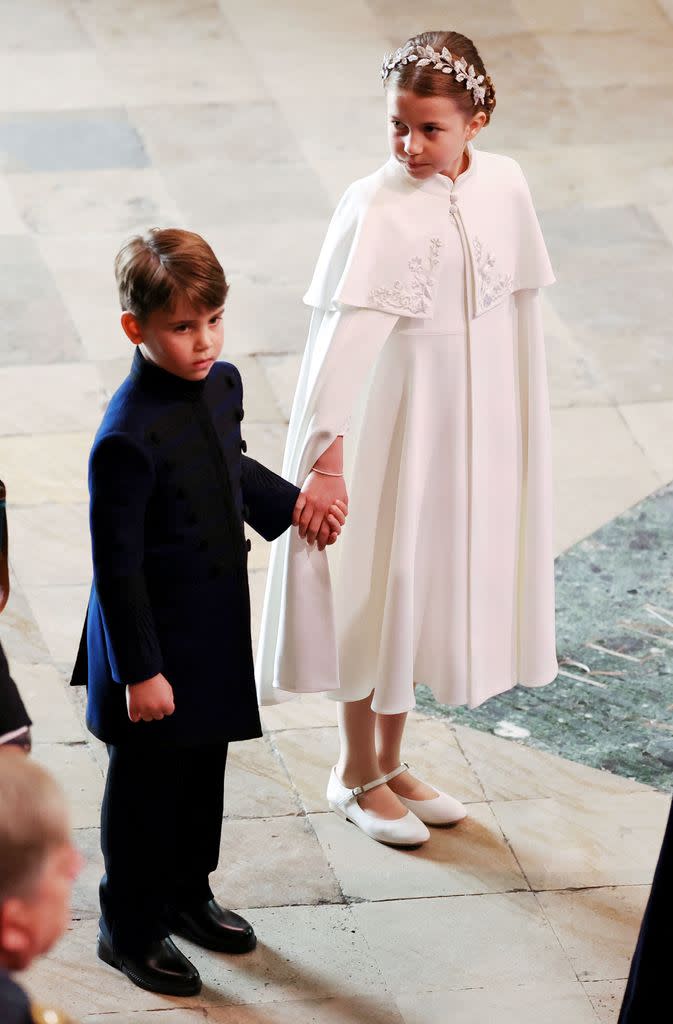
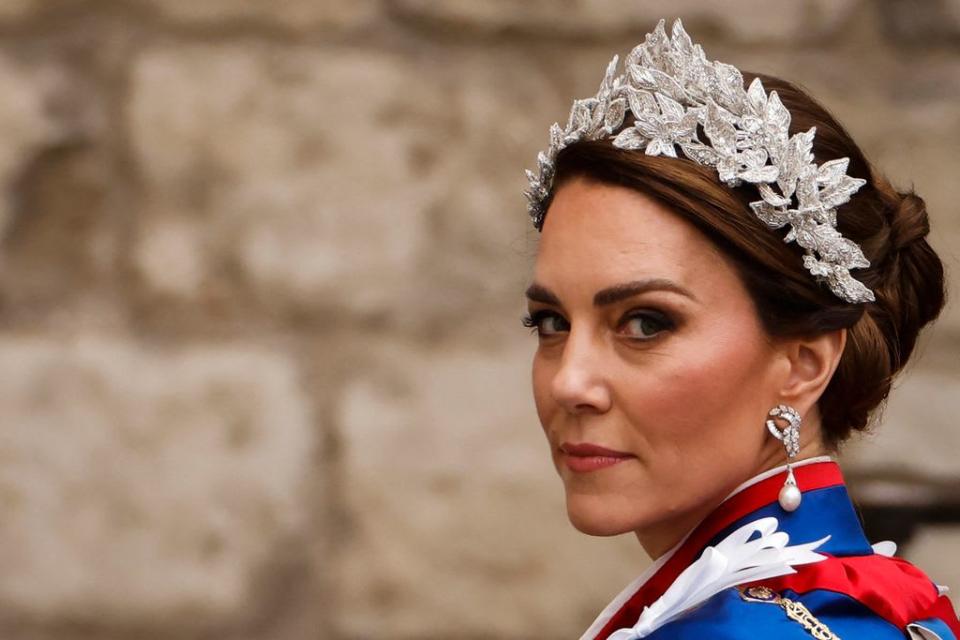
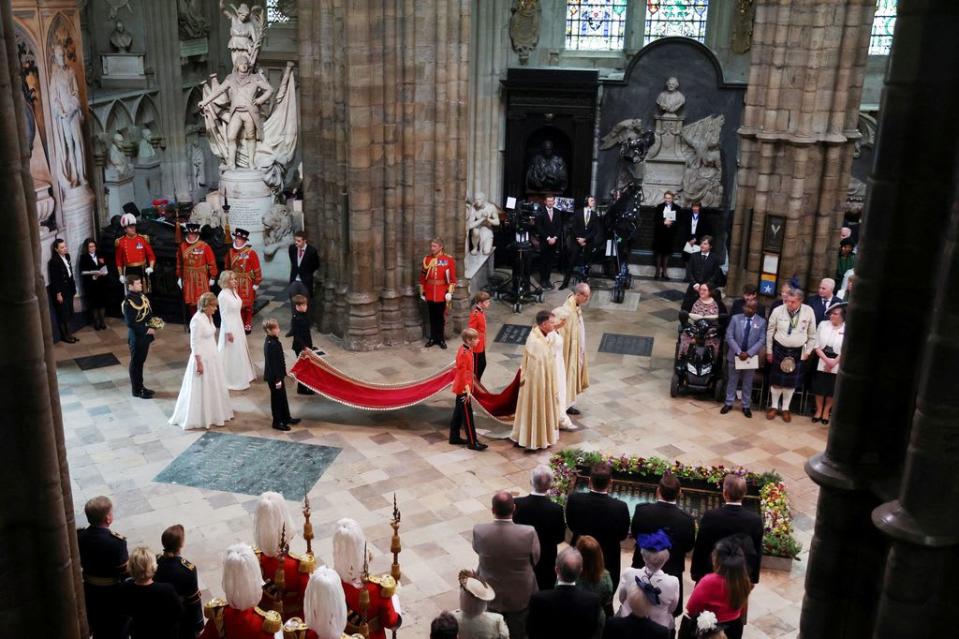
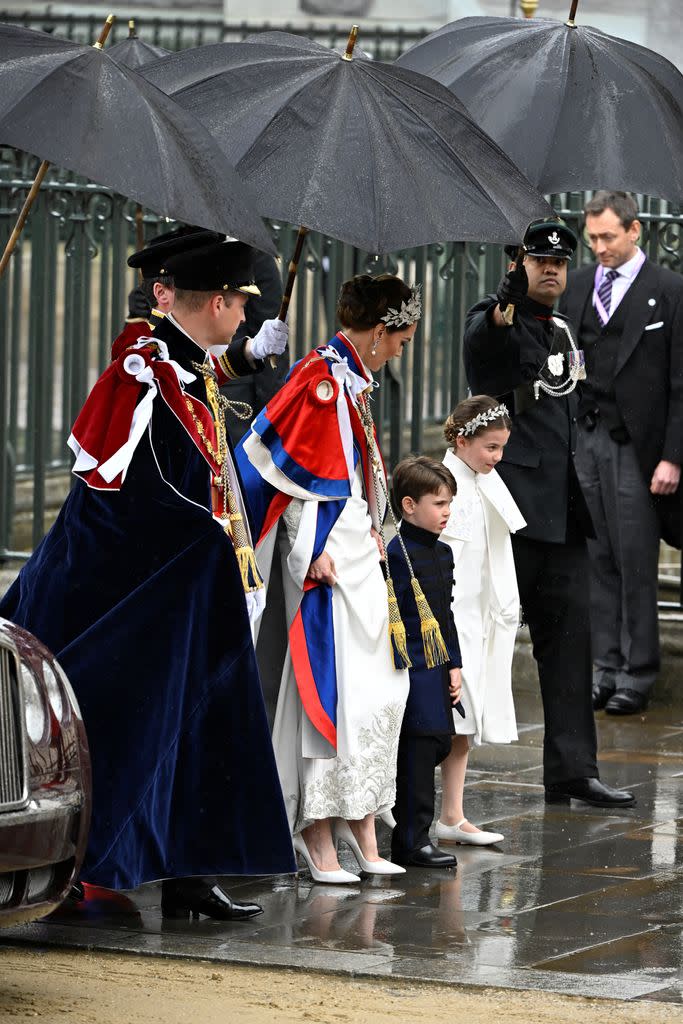

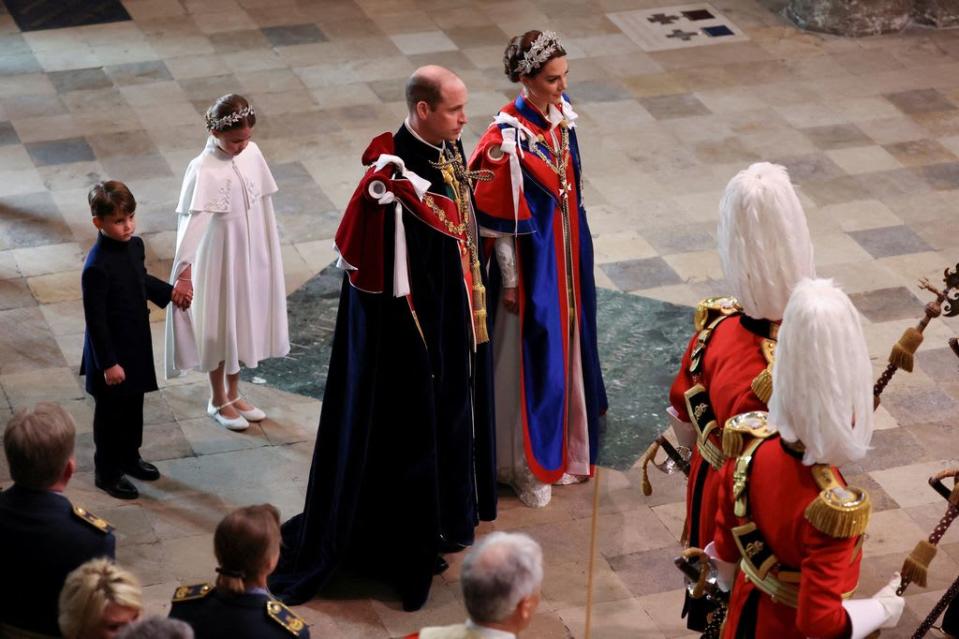
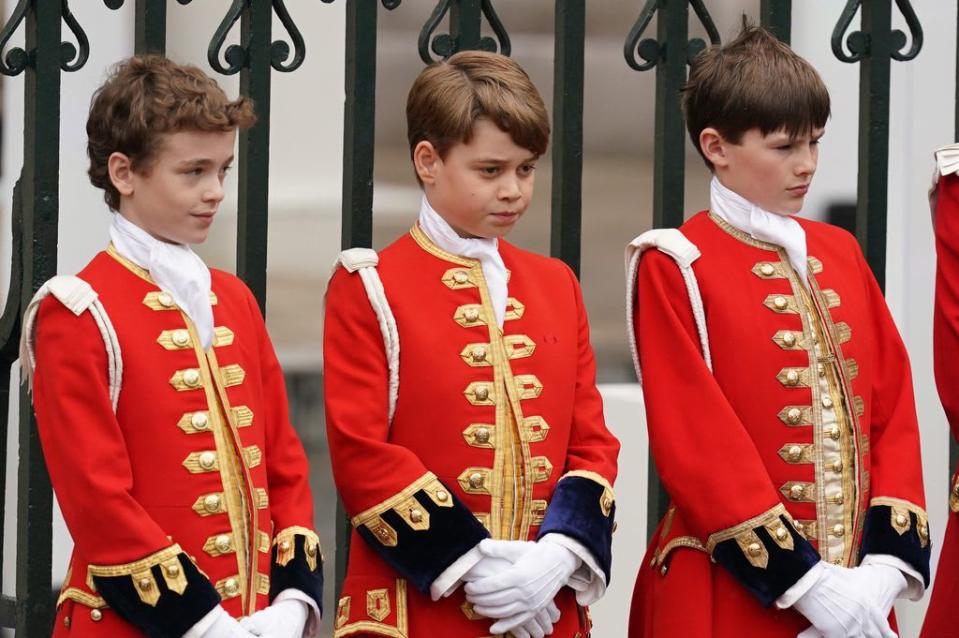
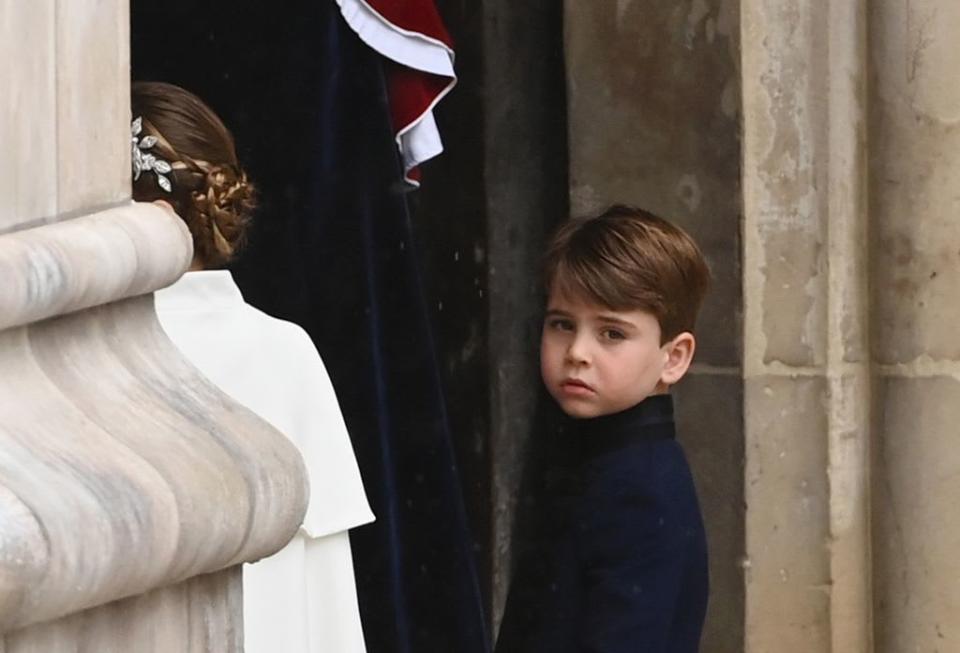
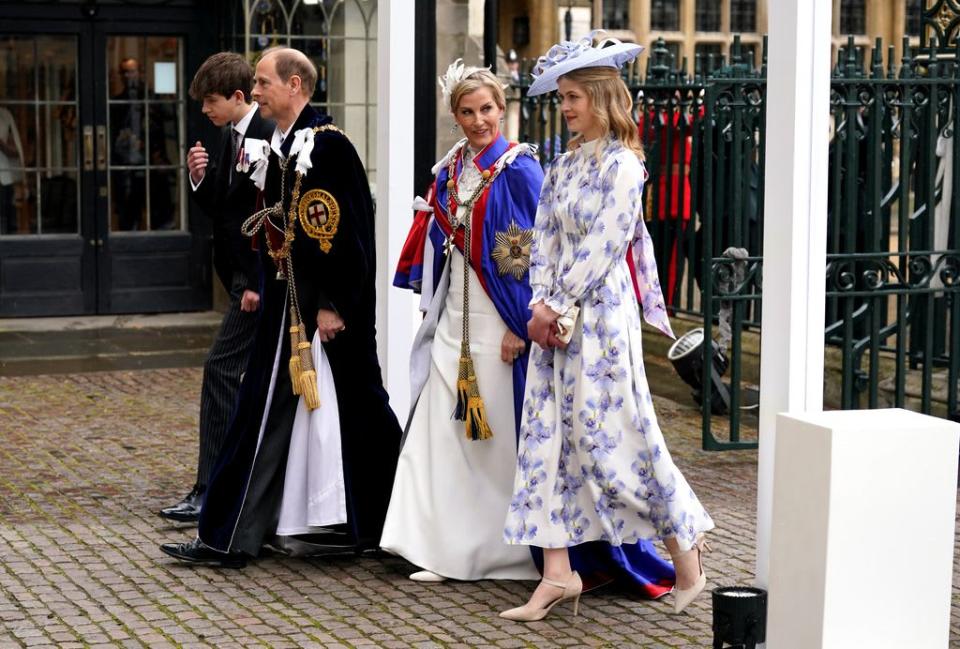
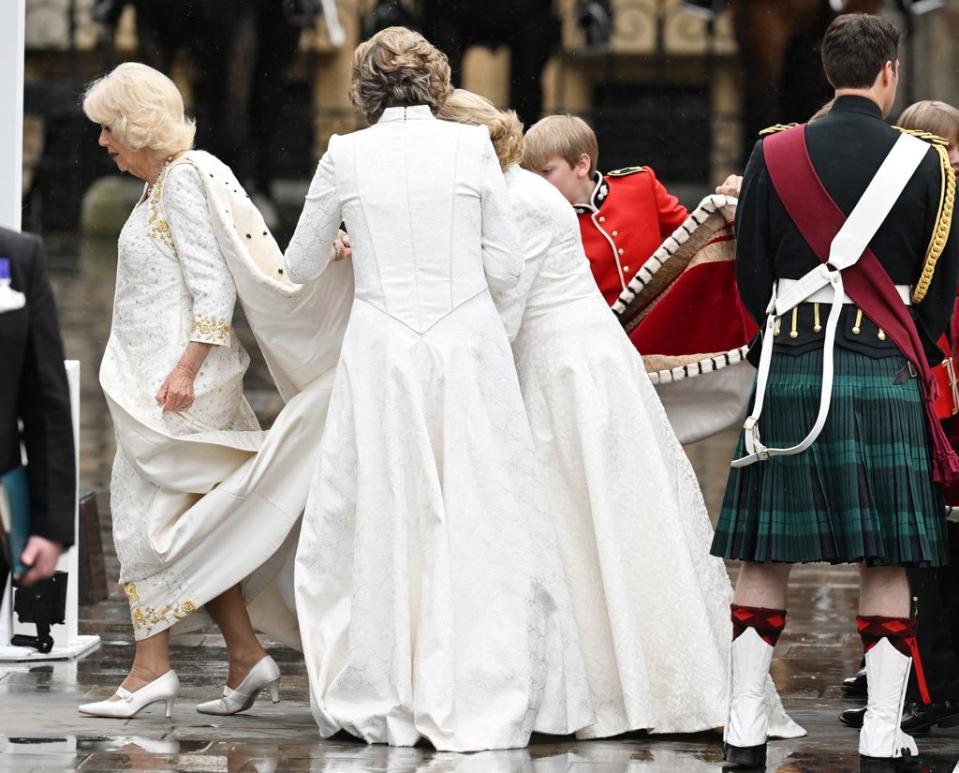
They stood in procession ahead of the ceremony, with Camilla and her pages at the front, followed by King Charles and his pages, and then the Prince and Princess of Wales and Prince Louis and Princess Charlotte.
The Queen looked resplendent as she slowly made her way down the aisle, followed by the King, as the choir sang out. The monarch smiled to members of the congregation as the procession continued, many of whom bowed, nodded their head, or curtseyed.
Prince Harry and other British royals arrive at the Abbey
At around 10:40, the British royal family started to make their entrance. Prince Harry arrived alongside cousins Princess Eugenie and Princess Beatrice, and their husbands. Zara Tindall walked in hand-in-hand with her husband, Mike, followed by the Duke and Duchess of Edinburgh.
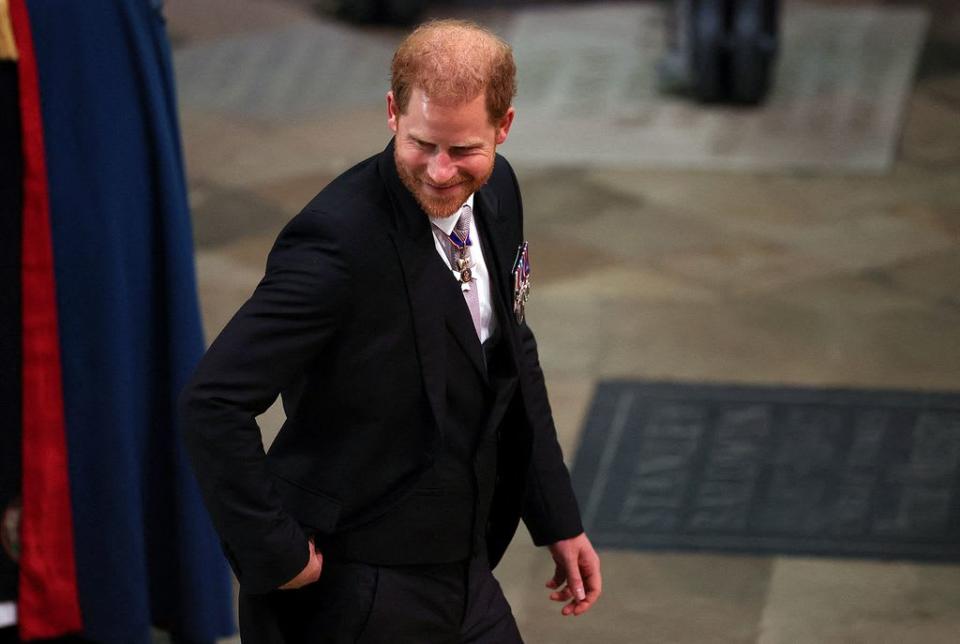
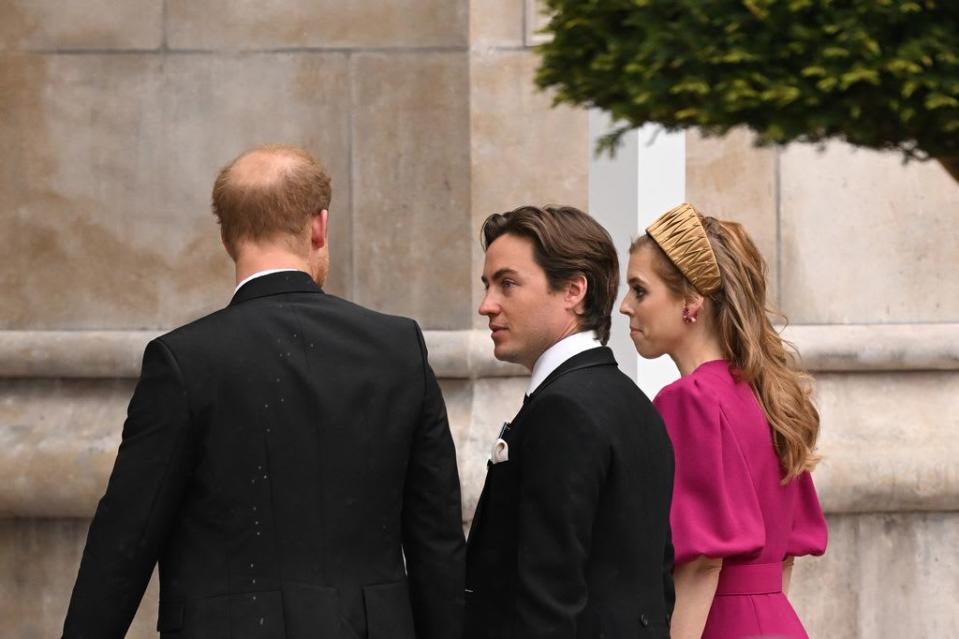
Princess Anne and her husband, Sir Timothy Laurence, were among the last to arrive. Anne is acting as her brother's Gold-Stick-in-Waiting, meaning she is entrusted with the monarch's personal safety. As such, she is wearing her military uniform and will lead the procession on horseback on the route back to Buckingham Palace.
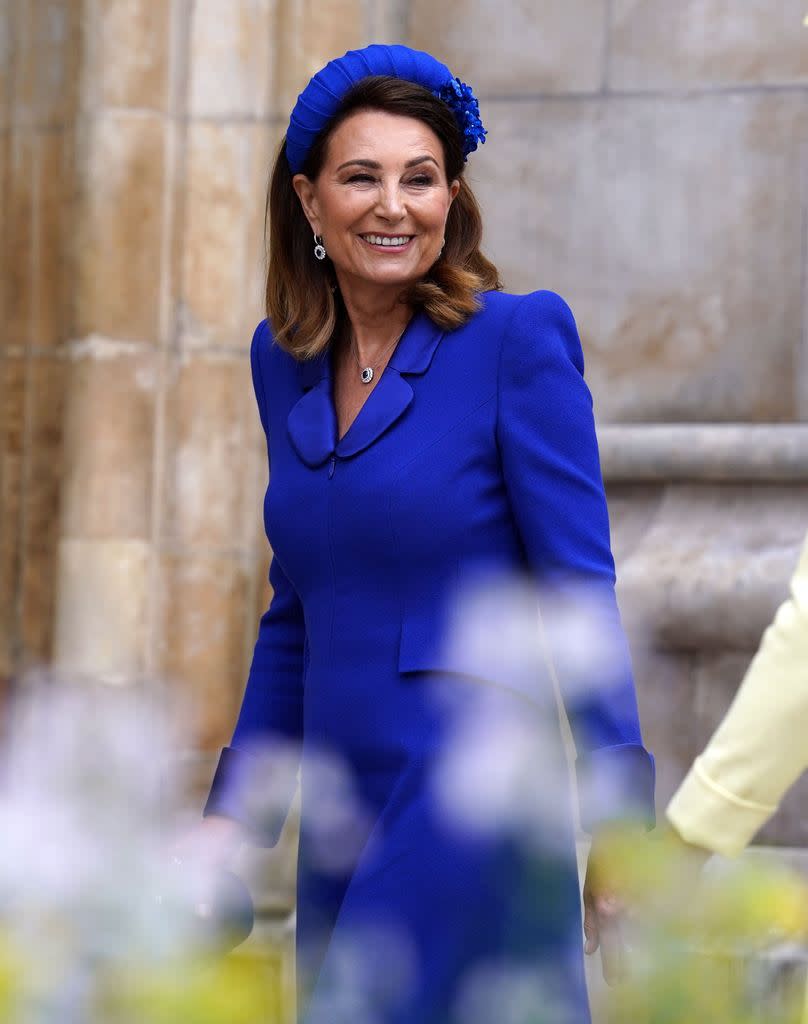
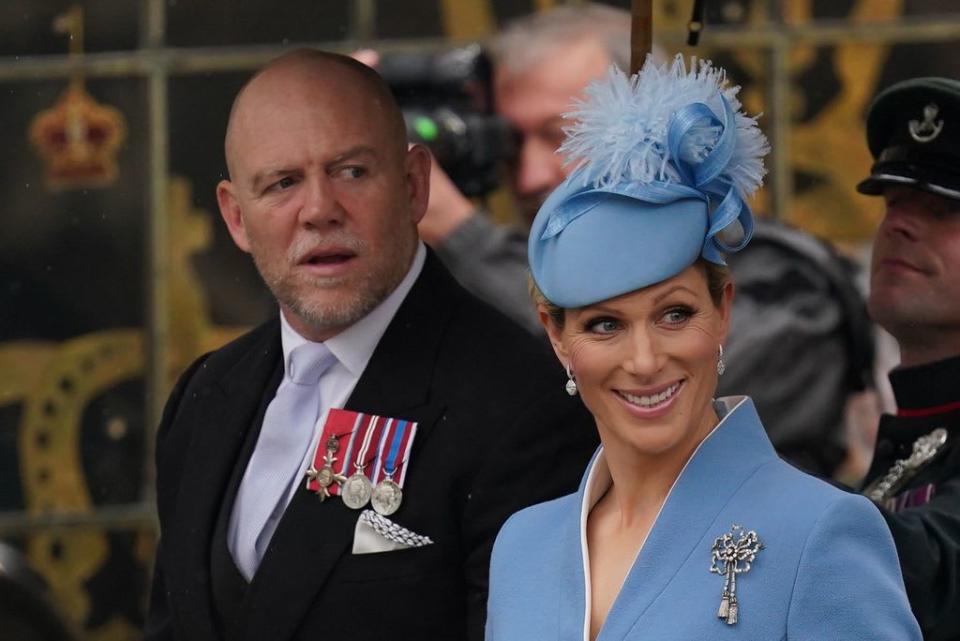
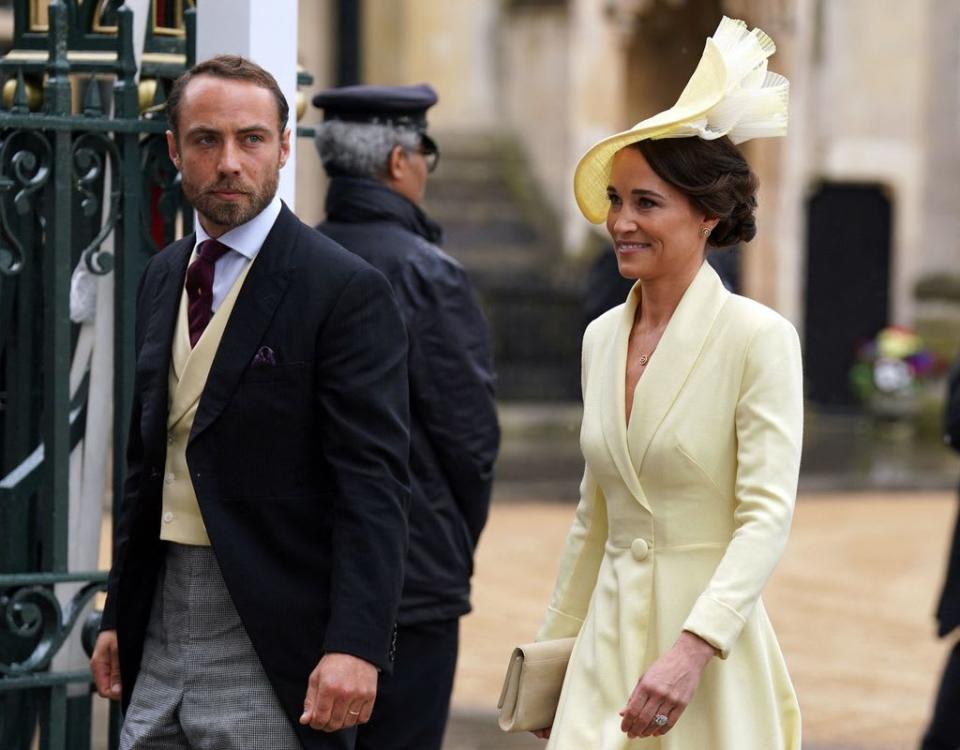
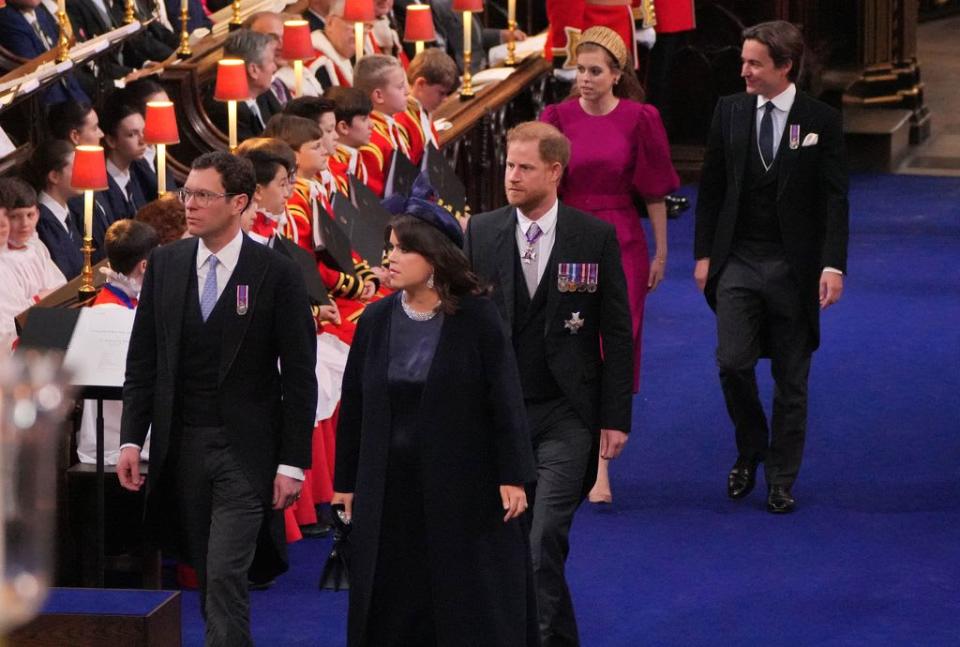
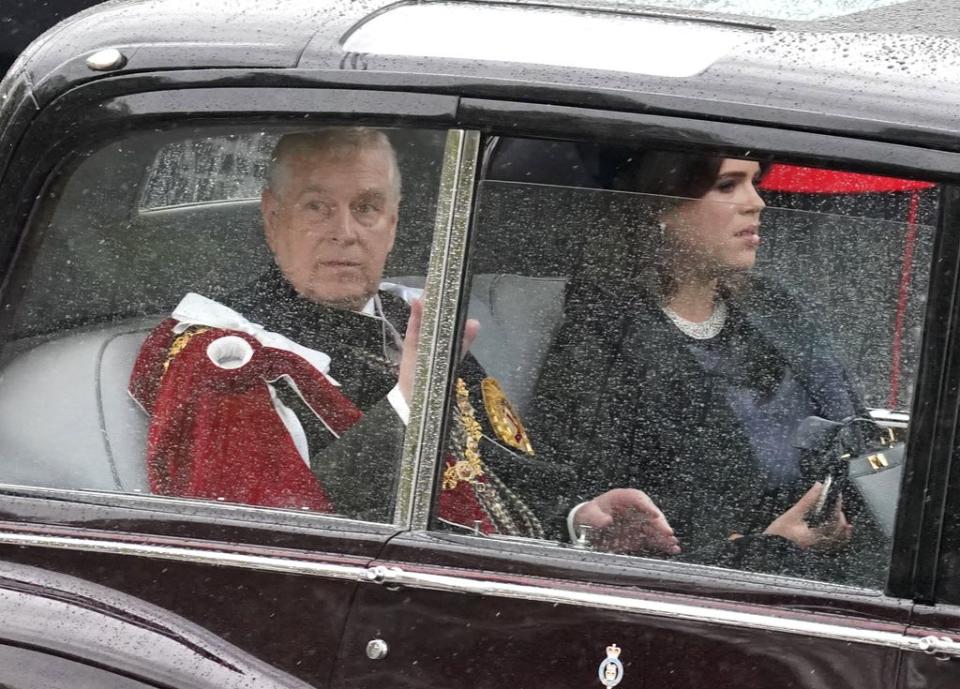
The procession to Westminster Abbey
At 10:20, the King and Queen left Buckingham Palace as God Save The King played out.
The outbound journey to Westminster Abbey is known as the King’s Procession. The return journey - featuring a much larger group - will be the Coronation Procession.
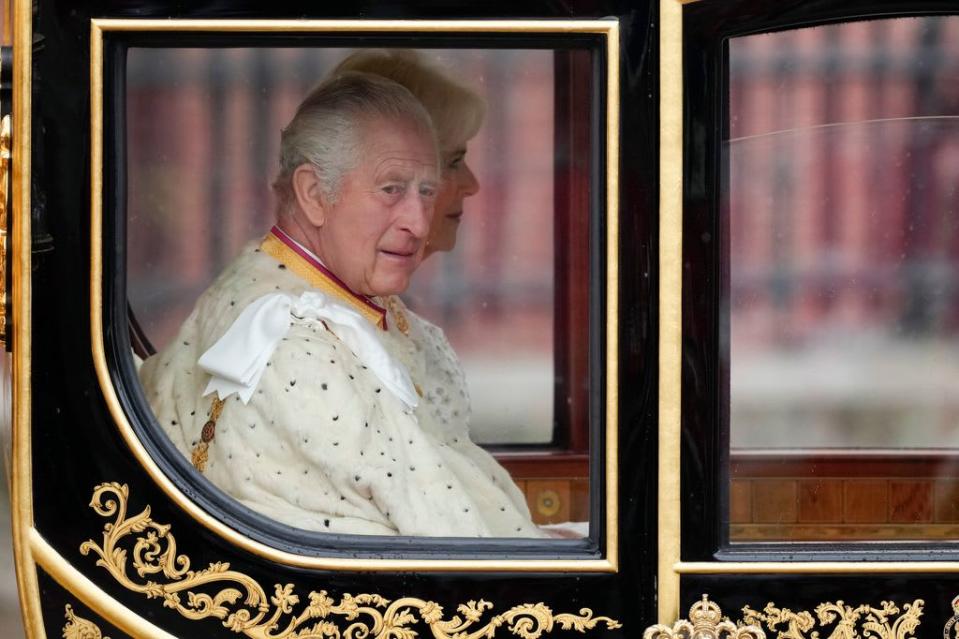
The couple smiled and waved as they made their way past thousands of cheering members of the public.

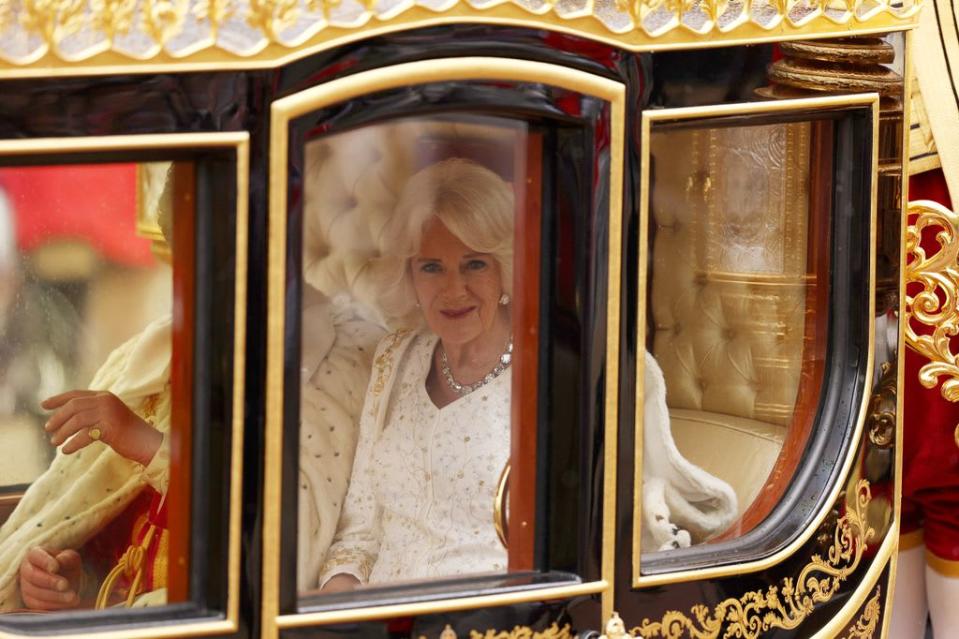
His Majesty is wearing the Robe of State, a Crimson Coronation Tunic and cream silk overshirt with Royal Naval trousers. Her Majesty The Queen is wearing a design by Bruce Oldfield, resembling a coat dress, with an embroidered underskirt underneath. Here's how it compares to what Charles's mother, Queen Elizabeth II, wore to her coronation in 1953.
Queen Elizabeth II's Coronation Gown
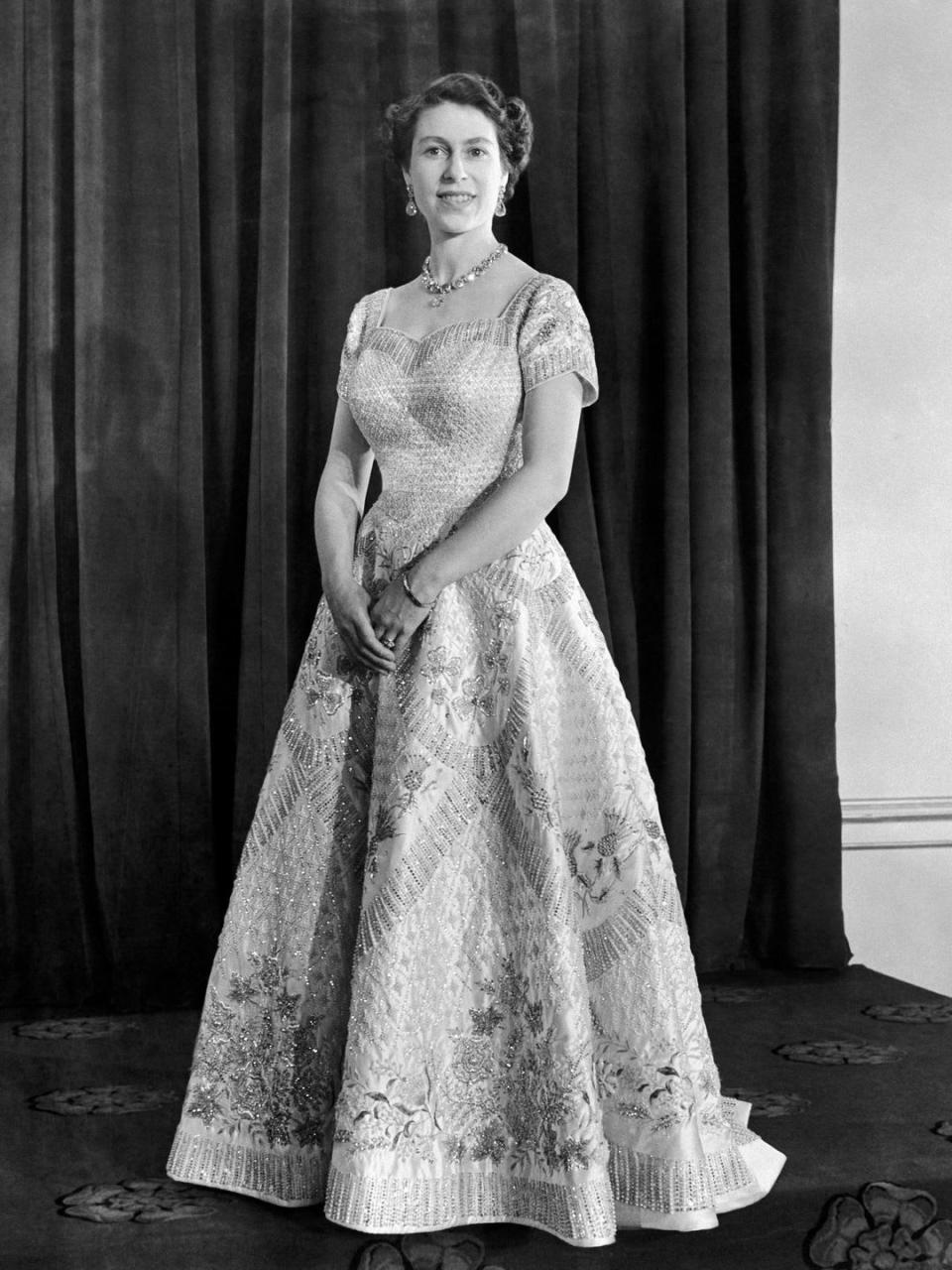
In 1953, a 25-year-old Queen Elizabeth II slipped into an extravagant white duchesse satin gown embroidered with strings of pearls, sequins and crystals. The Norman Hartnell-designed dress moreover featured embroidered national and Commonwealth floral emblems in gold, silver and pastel-coloured silks.On top of her sumptuous gown, the late monarch wore a six-and-a-half-metre Robe of Estate - made by royal robe-makers Ede & Ravenscroft. It took a team of 12 seamstresses, using 18 types of gold thread, a whopping 3,500 hours to complete the Queen’s velvet robe.
Charles and Camilla board the Diamond Jubilee Coach
The royal couple were photographed as they boarded the Diamond Jubilee Coach within the grounds of Buckingham Palace at around 10:15, ahead of their procession to Westminster Abbey.
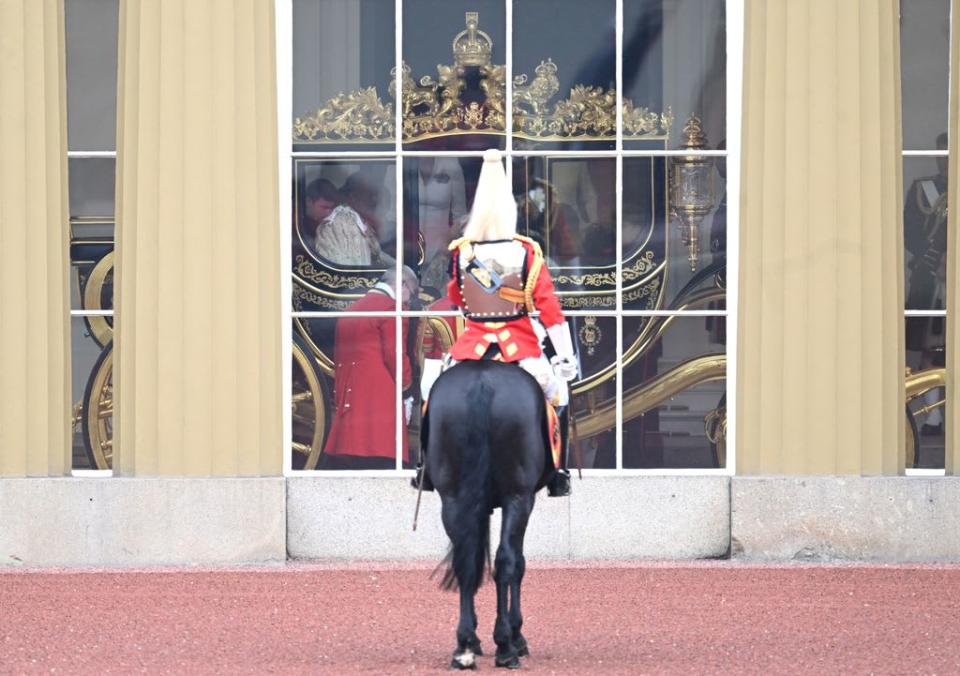
World royals start arriving
Shortly after 9.30am, world royals and global leaders started making their way inside the Abbey. Among the first to arrive was First Lady Dr. Jill Biden and her 23-year-old granddaughter, Finnegan Biden, representing the US. They chose colours of the Commonwealth - white and blue. US President Joe Biden is not in attendance - find out why here.
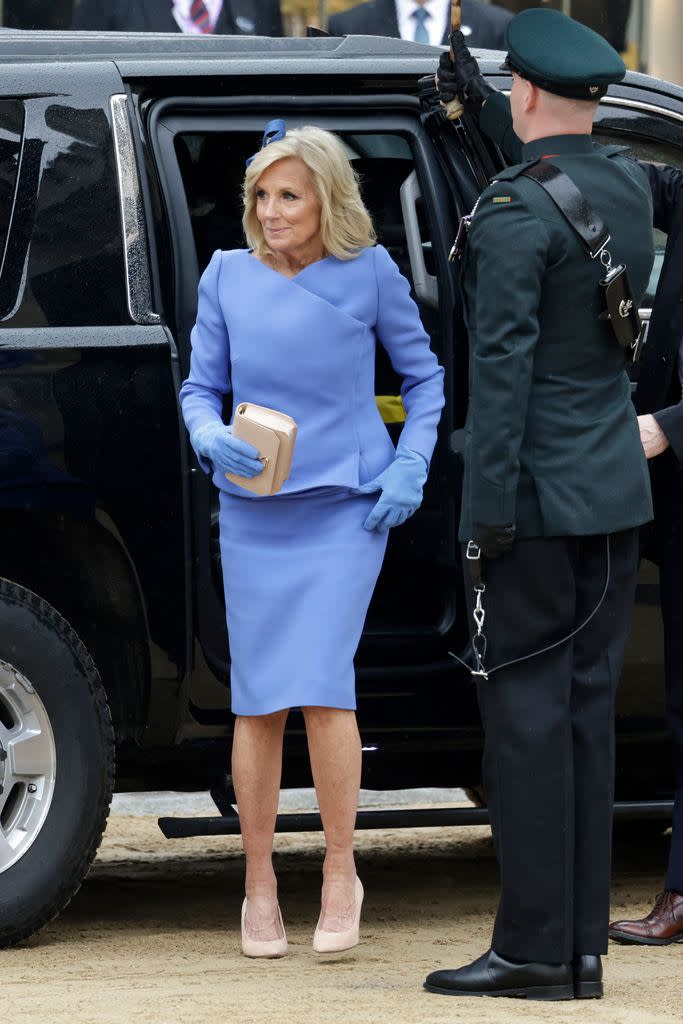
French president Emmanuel Macron and his wife Brigitte Macron arrived arm-in-arm at 9.50, followed by Israel's President Isaac Herzog and his wife Michal. Ukraine's First Lady Olena Zelenska arrived with Prime Minister Denys Shmyhal.
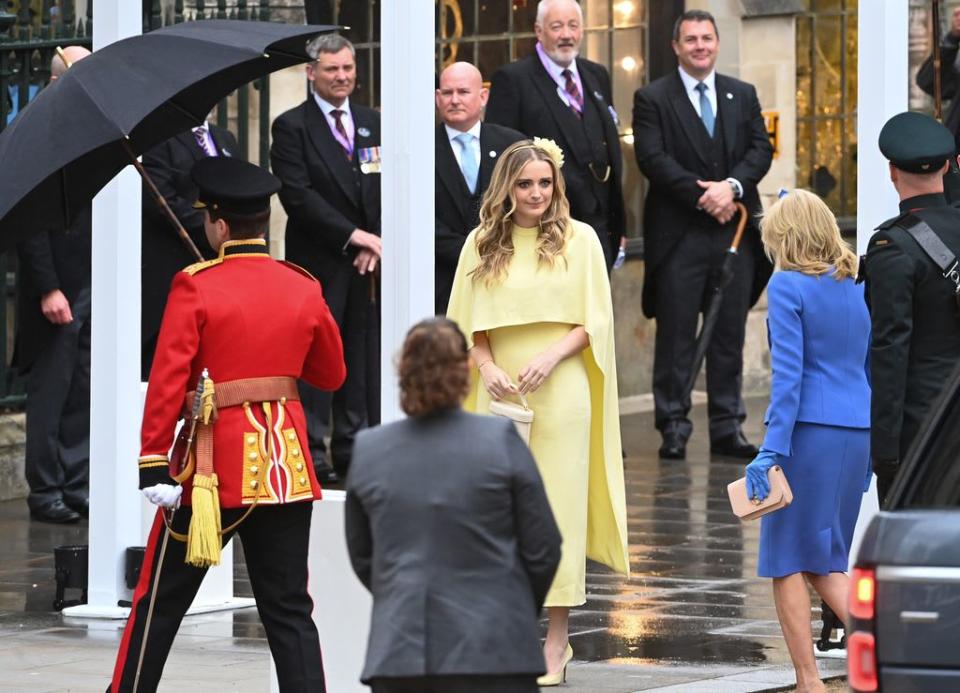
Queen Letizia of Spain looked incredibly elegant in a pink two-piece by Carolina Herrera and a wide-brimmed hat, while husband King Felipe was dressed in his military uniform.
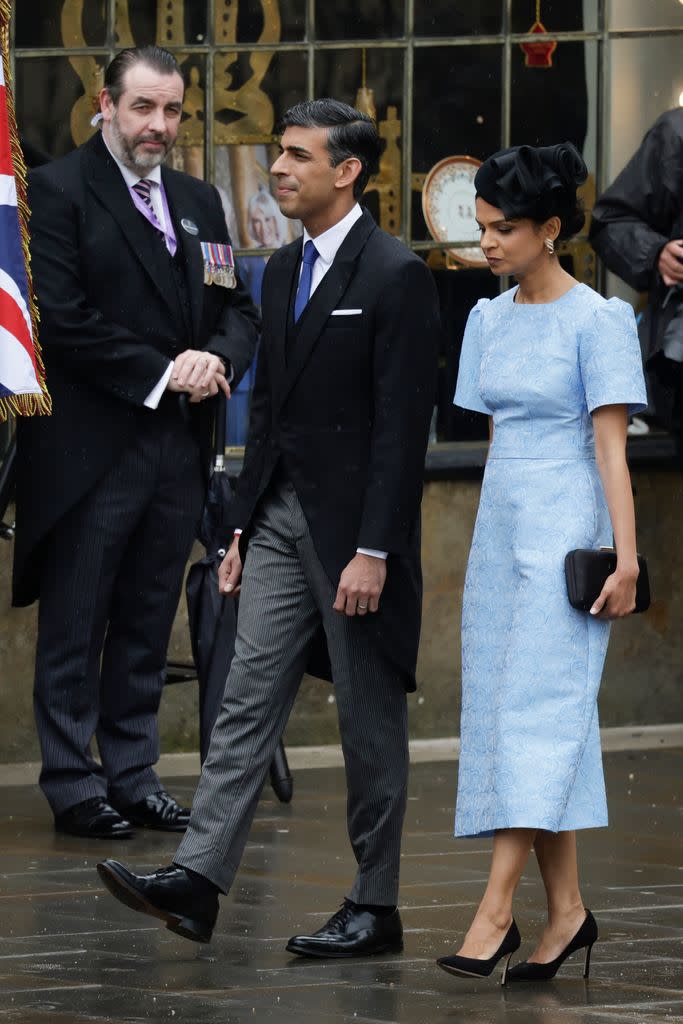
Former Prime Ministers Gordon Brown, Tony Blair and David Cameron arrived together with their wives shortly before 10.15 followed by Teresa May, Boris Johnson and Liz Truss. Rishi Sunak attended with his wife Akshata Murthy.
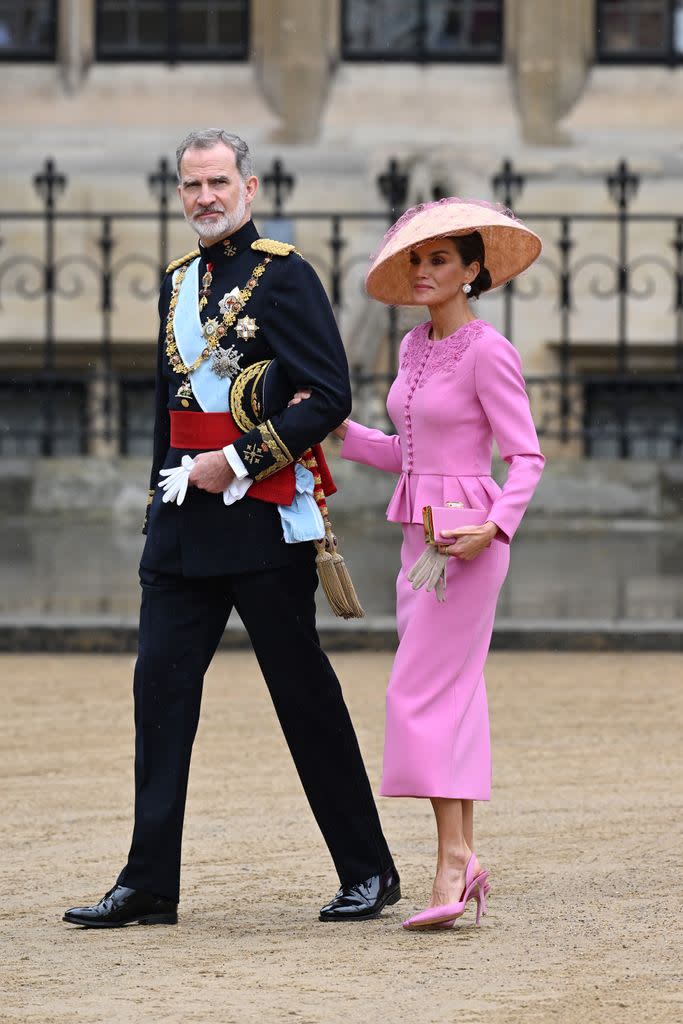
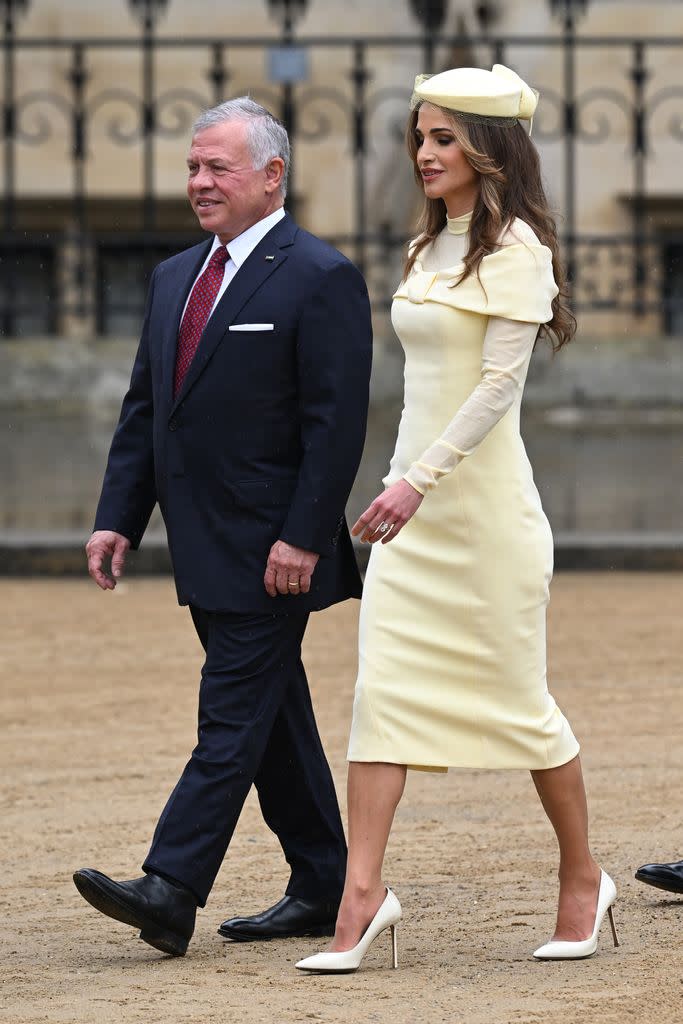

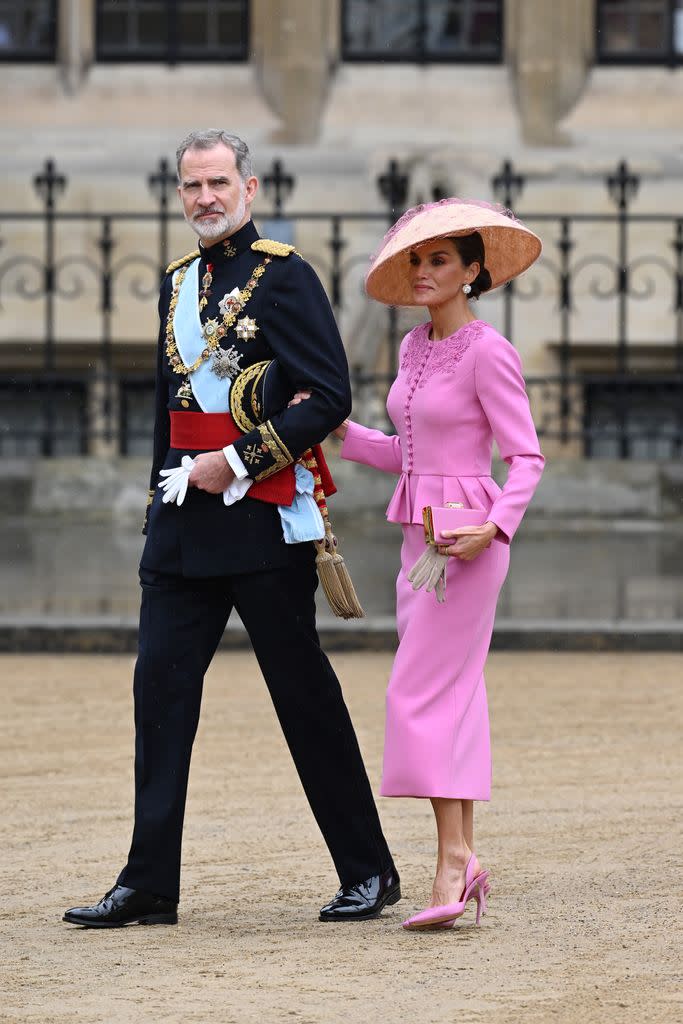
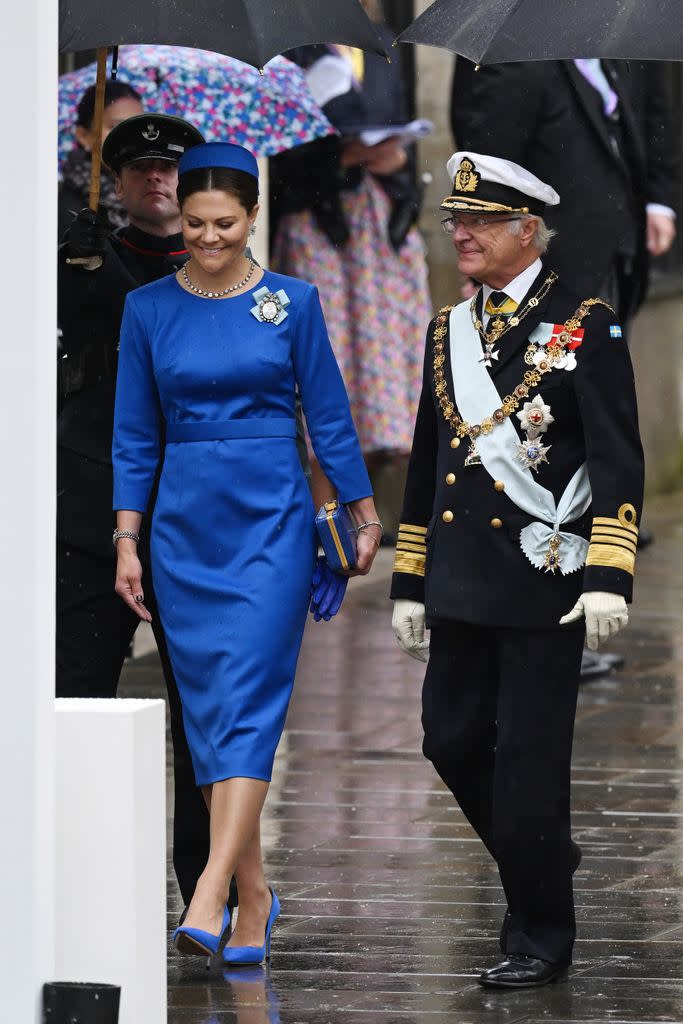
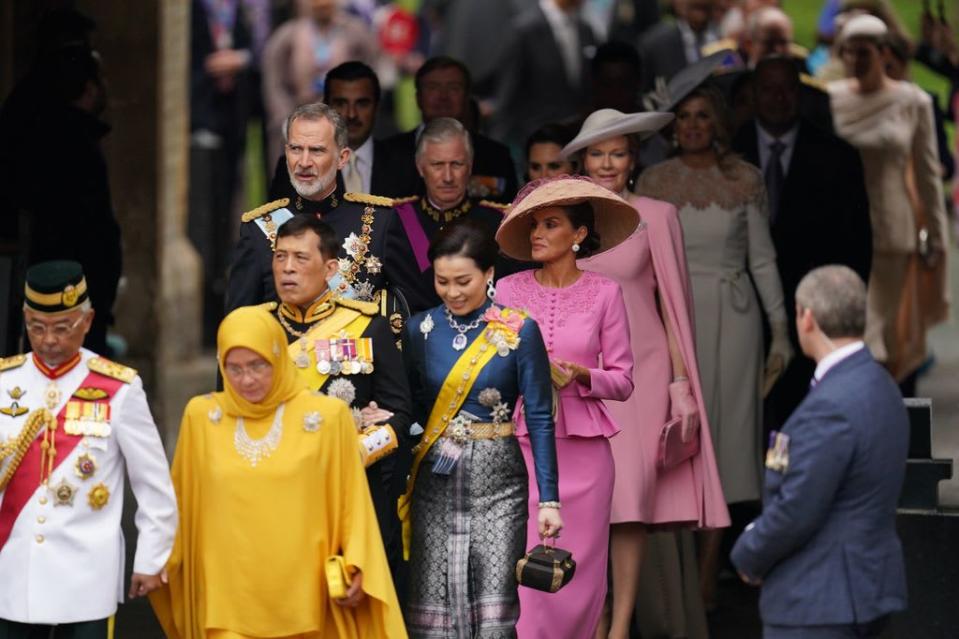
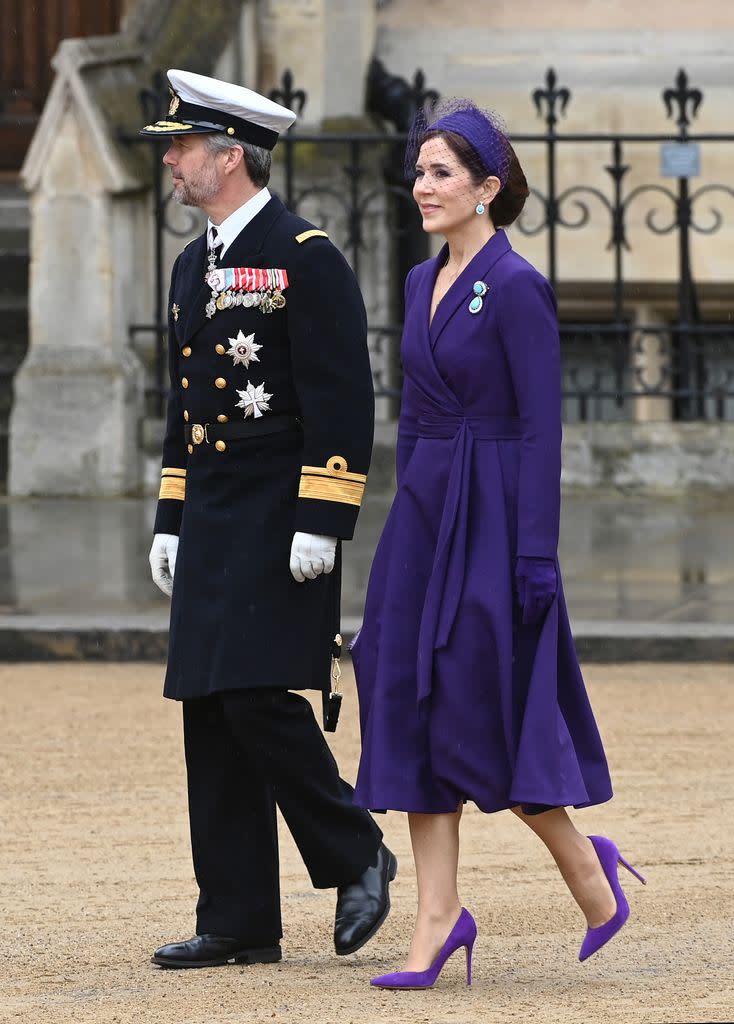
King Charles and Queen Camilla leave Clarence House in the State Bentley
At 9.10, the royal couple left Clarence House bound for Buckingham Palace. They were driven in the maroon State Bentley.
Two State Bentleys were manufactured by Bentley as a gift for the Queen for her Golden Jubilee in 2002.
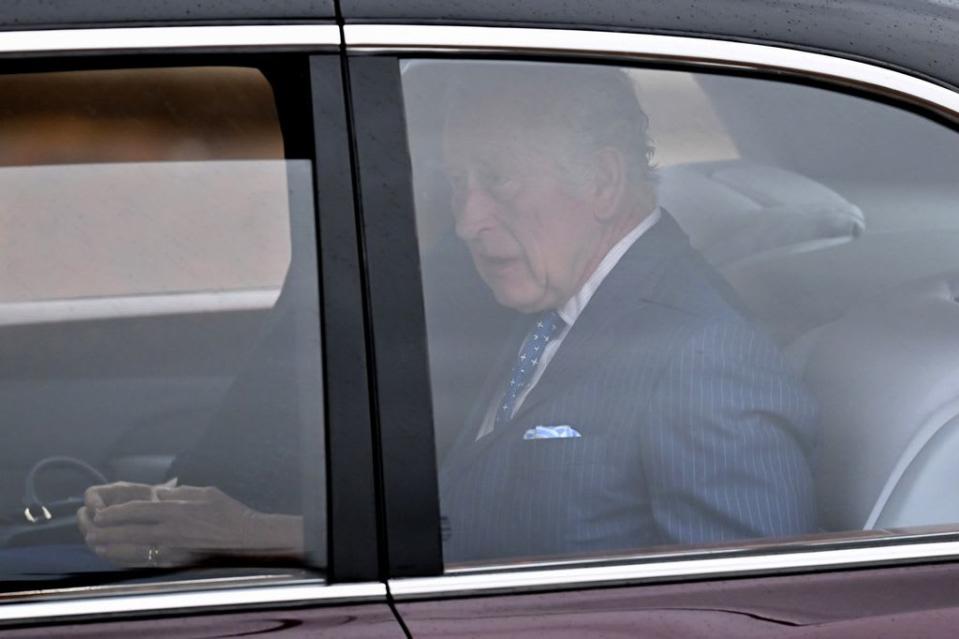
For the occupants' protection, the bodywork and glass are armoured while the cabin can be sealed in case of a gas attack and is also blast-resistant, while the tyres are Kevlar-reinforced.
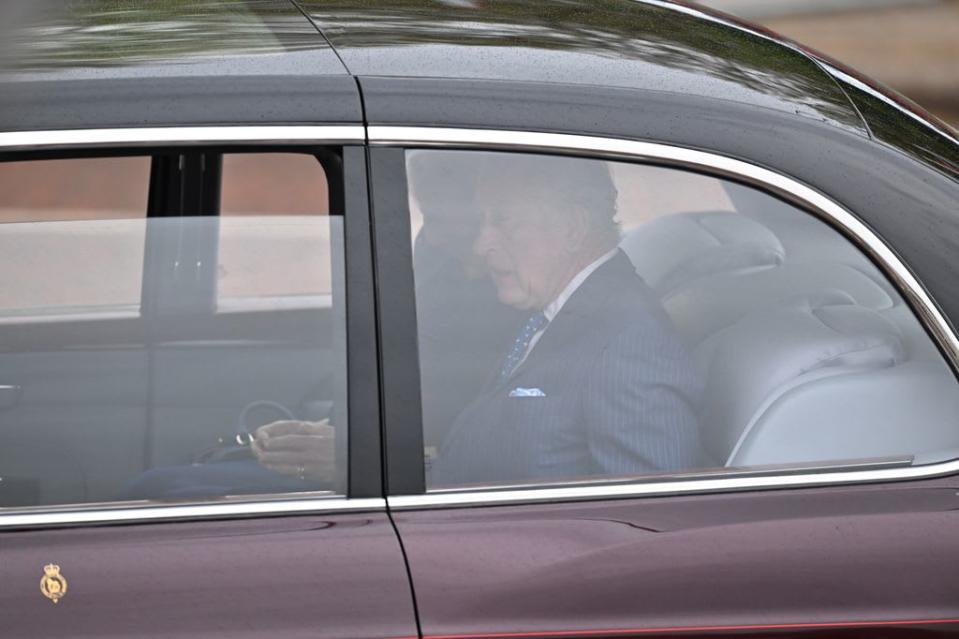
The Queen used the cars up until her death in September 2022, and the Princess Royal travelled in the State Bentley while accompanying her mother's coffin as it made its way to London from Scotland.
Westminster Abbey
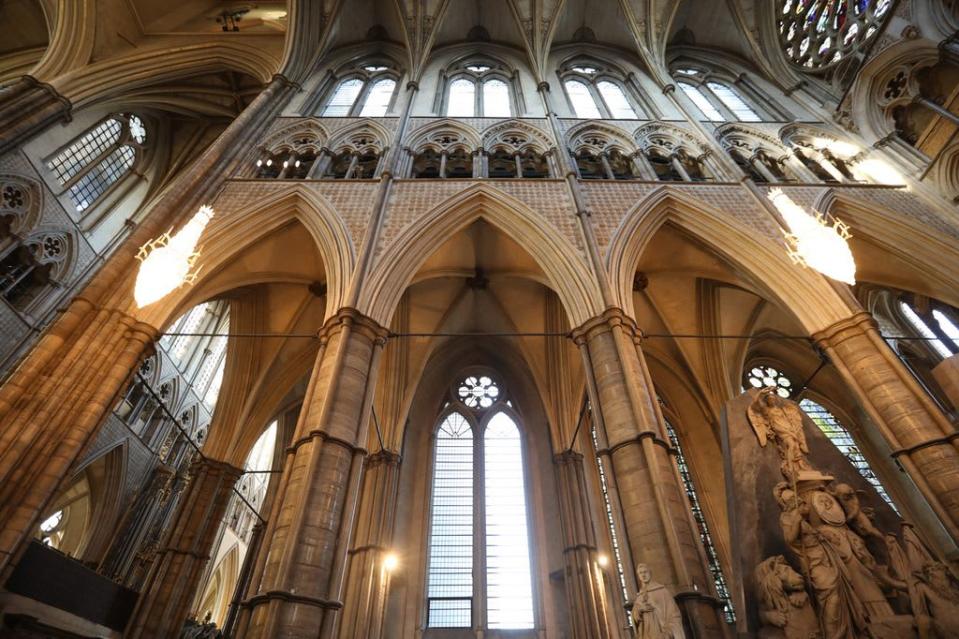
London's Westminster Abbey has played host to every coronation since 1066, with King Charles III set to be the 40th reigning monarch to be crowned there. The historic church was originally built by Edward the Confessor in 1040 and is the burial site for 18 monarchs in addition to some of the nation's greatest poets, musicians, scientists and politicians.
The abbey – which has been granted UNESCO World Heritage Site status – boasts spectacular gothic exteriors, splendid, vaulted ceilings and mesmerising mosaic floors. Other highlights include the ancient Coronation Chair, the glorious Lady chapel, and David Hockney's vibrant stained glass window.
Guests start arriving
From around 8am, lucky invitees started arriving at Westminster Abbey. As per instruction, members of the congregation had to be seated by 9am, including Dame Emma Thompson, Lady Susan Hussey, Lionel Richie, Ant and Dec, Jay Blades, Dynamo, Katy Perry, Edward Enninful, and Dame Joanna Lumley.
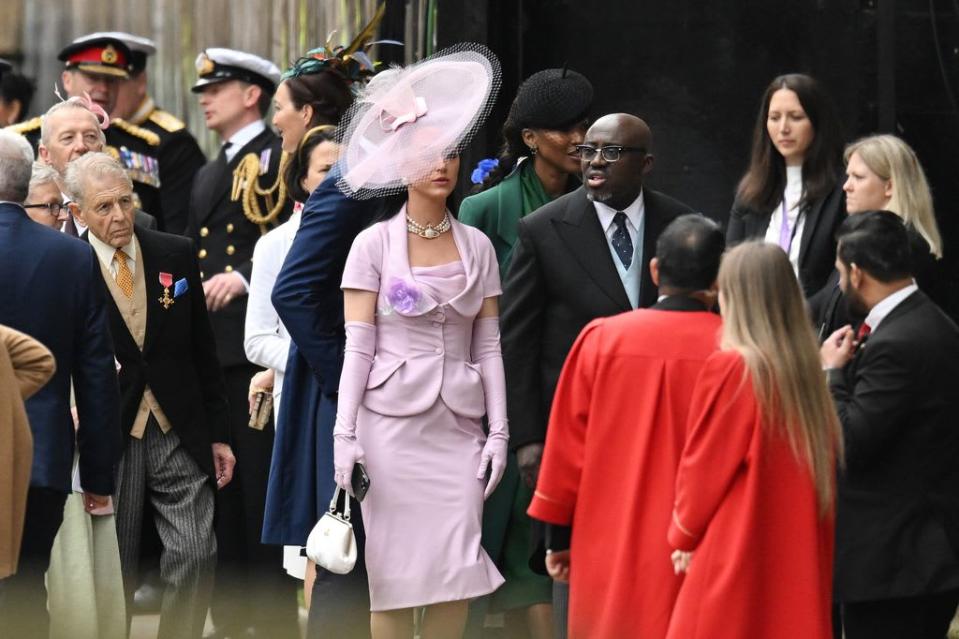
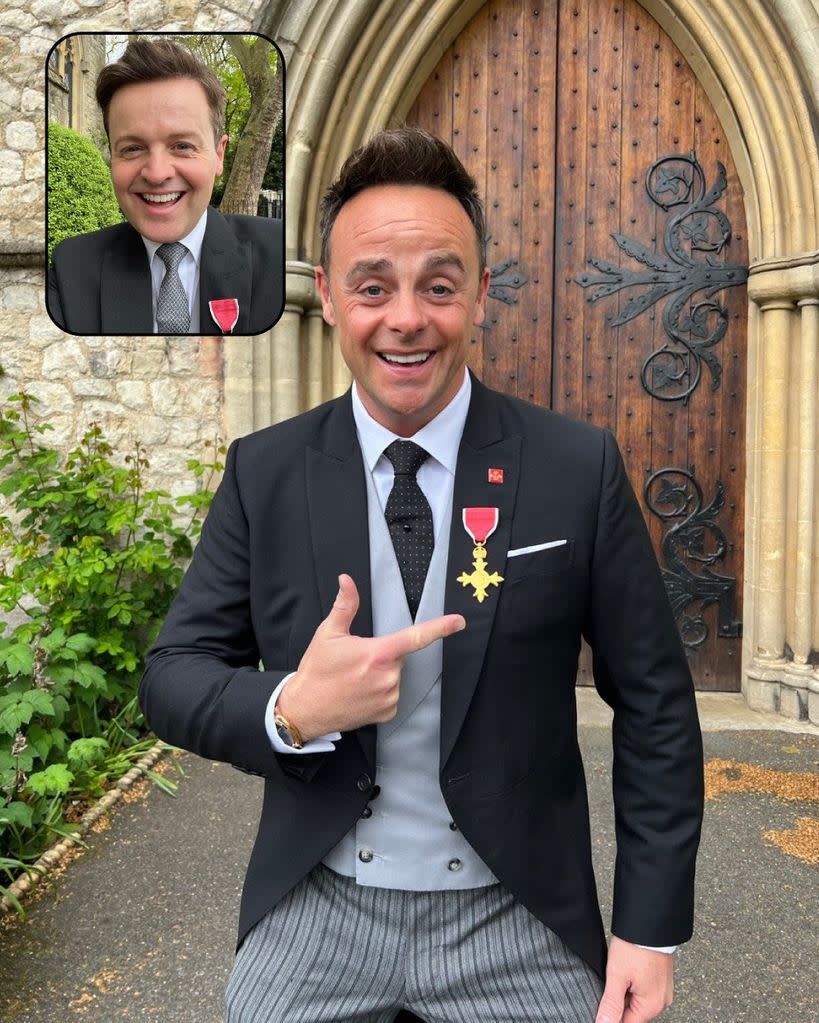
Of course, a large contingent of royals from around the world are also attending the coronation - find out who here.
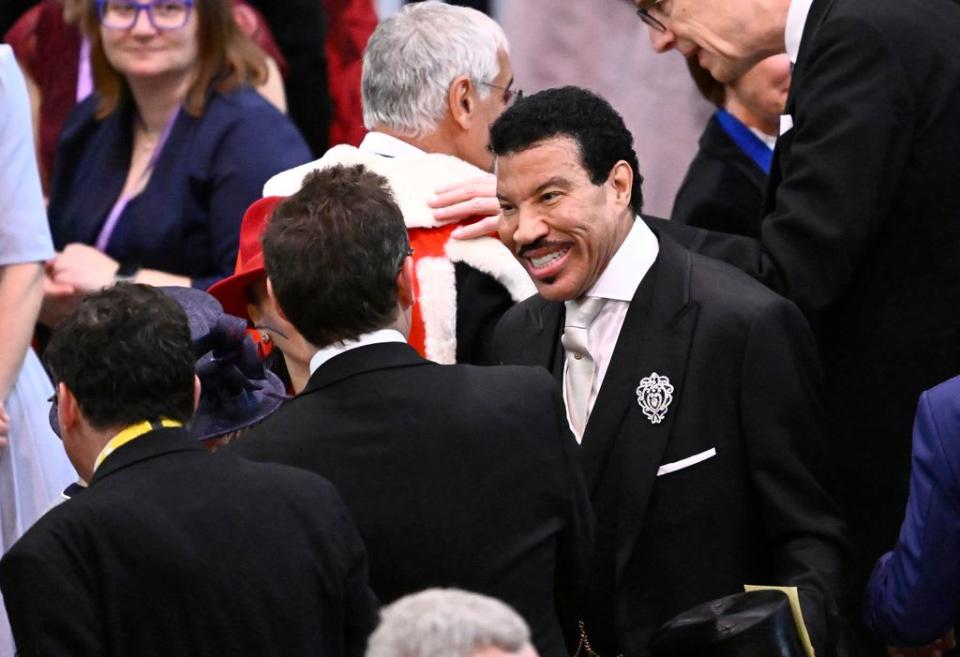
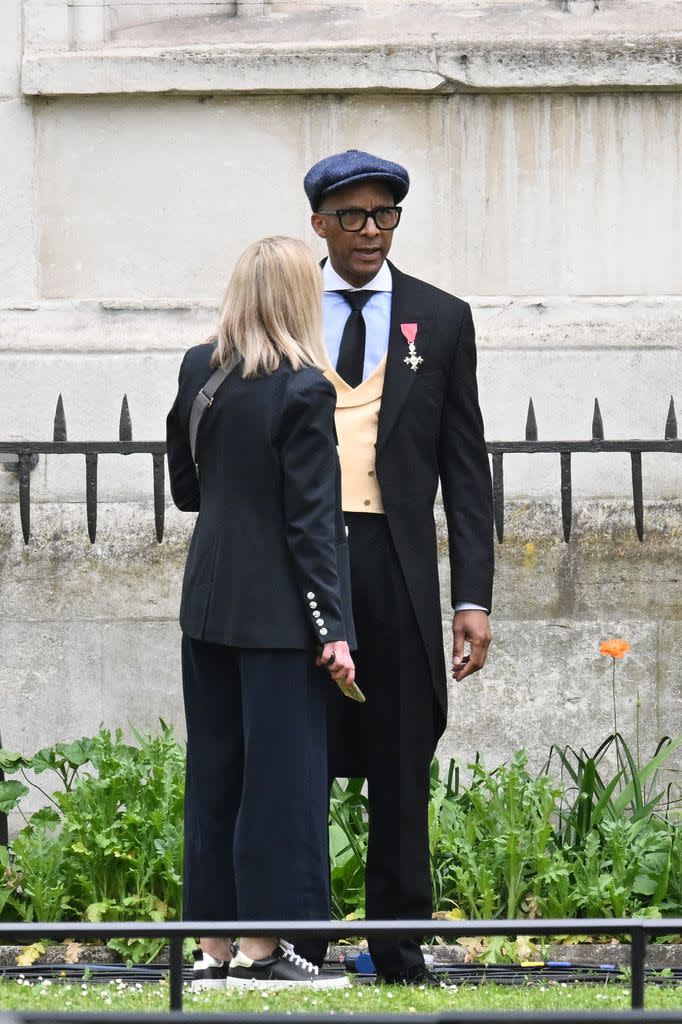
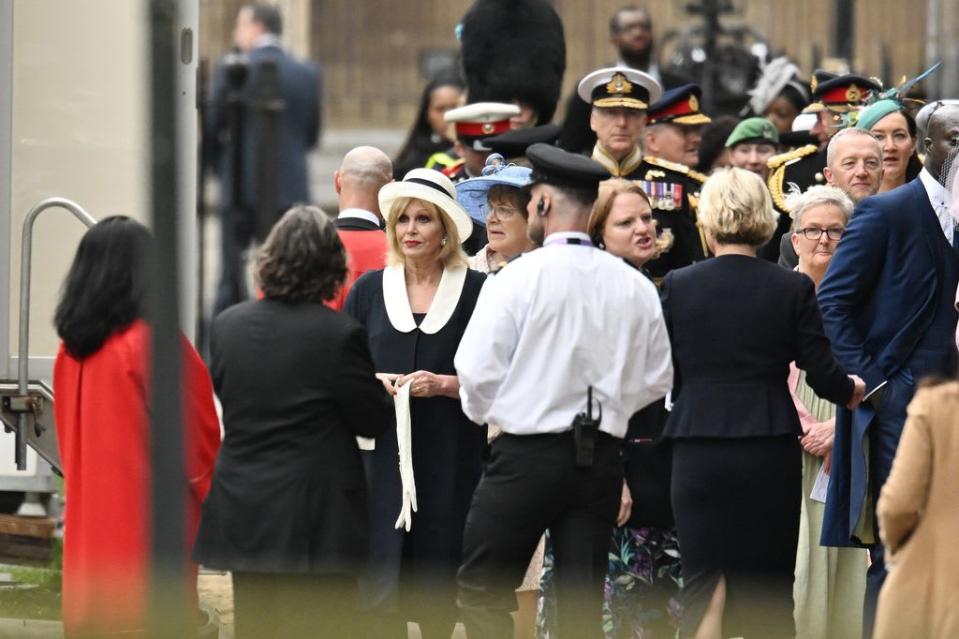
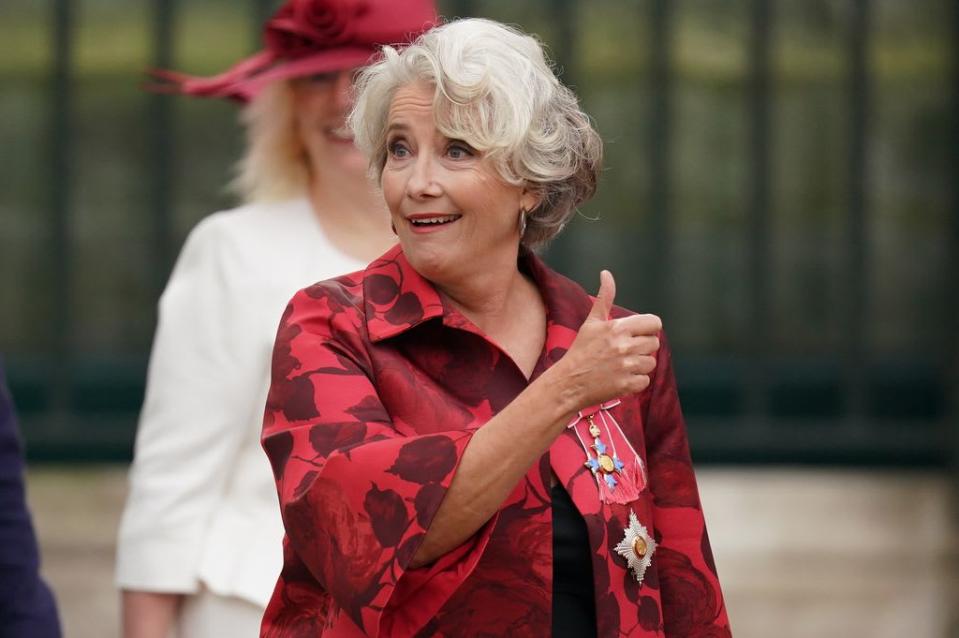
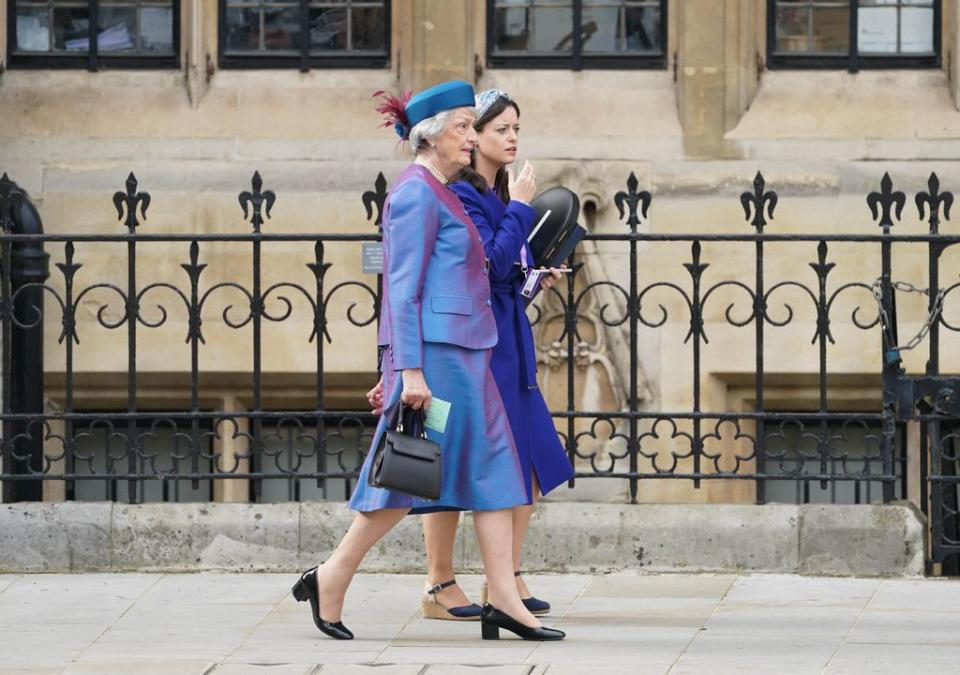
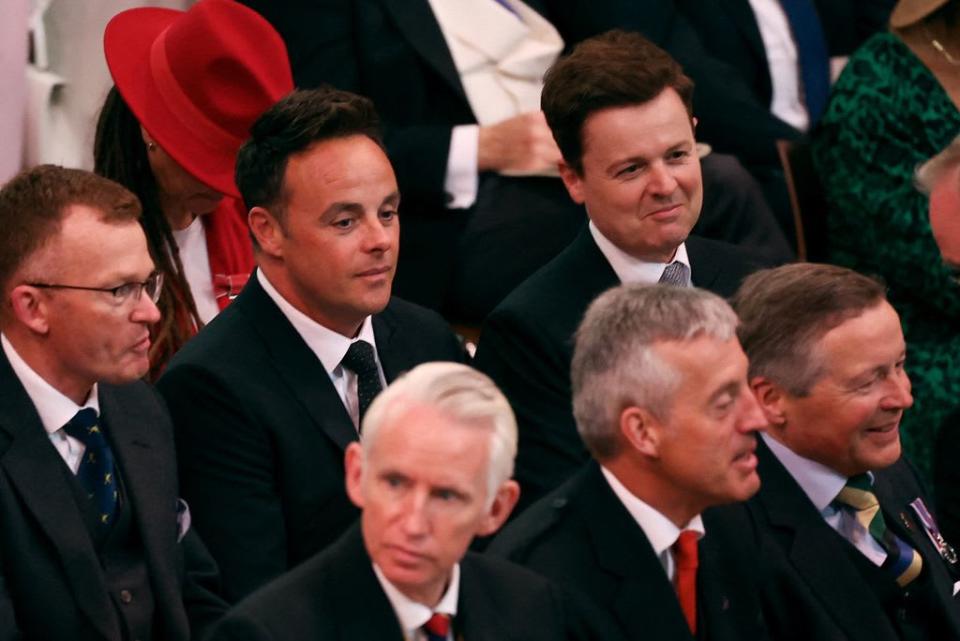
What will happen at the coronation?
There are several stages to the coronation. The recognition will see Charles presented to those gathered in the Abbey by the Archbishop of Canterbury as he stands by the 700-year-old coronation chair.
The King will then take his oath, swearing to uphold the law and the Church of England before the anointing.
DISCOVER: King Charles's coronation crown jewels - your guide to all of the historic regalia
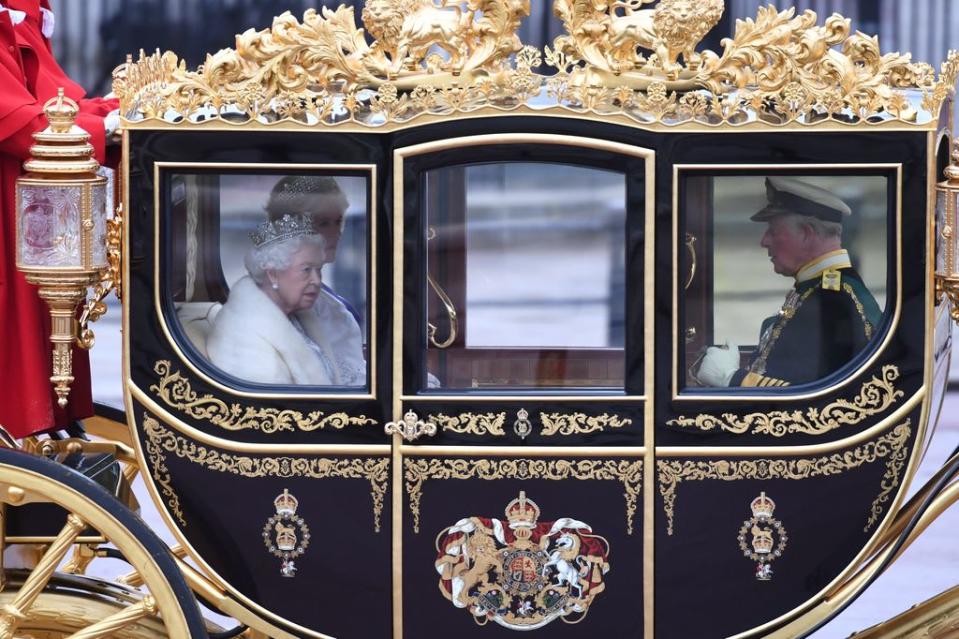
At this point, Charles's ceremony robe will be removed as he takes his seat on the chair. A gold cloth will be held over the chair to conceal the King from view. The Archbishop of Canterbury will then anoint Charles’s hands, breast and head with holy oil made according to a secret recipe, but known to contain ambergris, orange flowers, roses, jasmine and cinnamon.
For the investiture, the King will put on a sleeveless white garment called the Colobium Sindonis and an embroidered band of gold silk to wear around his shoulders, known as the Coronation Stole.
Justin Welby
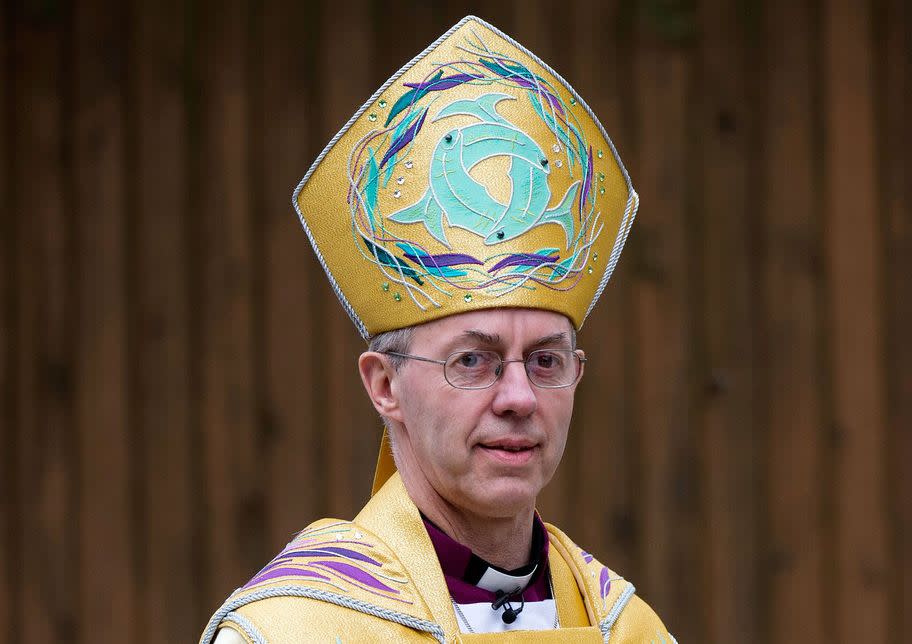
Justin Welby has served as the 105th Archbishop of Canterbury since 2013. He was ordained in 1992 and later served as a Canon of Coventry Cathedral in 2002. Beyond this, he was Dean of Liverpool from 2007 to 2011 and Bishop of Durham from 2011 to 2012. Justin studied at Eton College and at Trinity College, Cambridge, where he earned a master’s degree in history and law. He later studied at St. John's College, Durham, where he graduated with a bachelor’s degree and a diploma in theology. The Archbishop of Canterbury will conduct an Anglican service at the King's coronation. The service will be steeped in tradition and will include six basic stages: The recognition, the oath, the anointing, the investiture, the enthronement, and the homage.
He will then be presented with items including the Royal Orb, representing religious and moral authority; the Sceptre, representing power; and the Sovereign's Sceptre, a rod of gold topped with a white enamelled dove, a symbol of justice and mercy. Finally, the Archbishop places St Edward's Crown on the King's head.
SEE: First look at Queen Consort Camilla’s coronation robes - including sweet tribute to late Queen
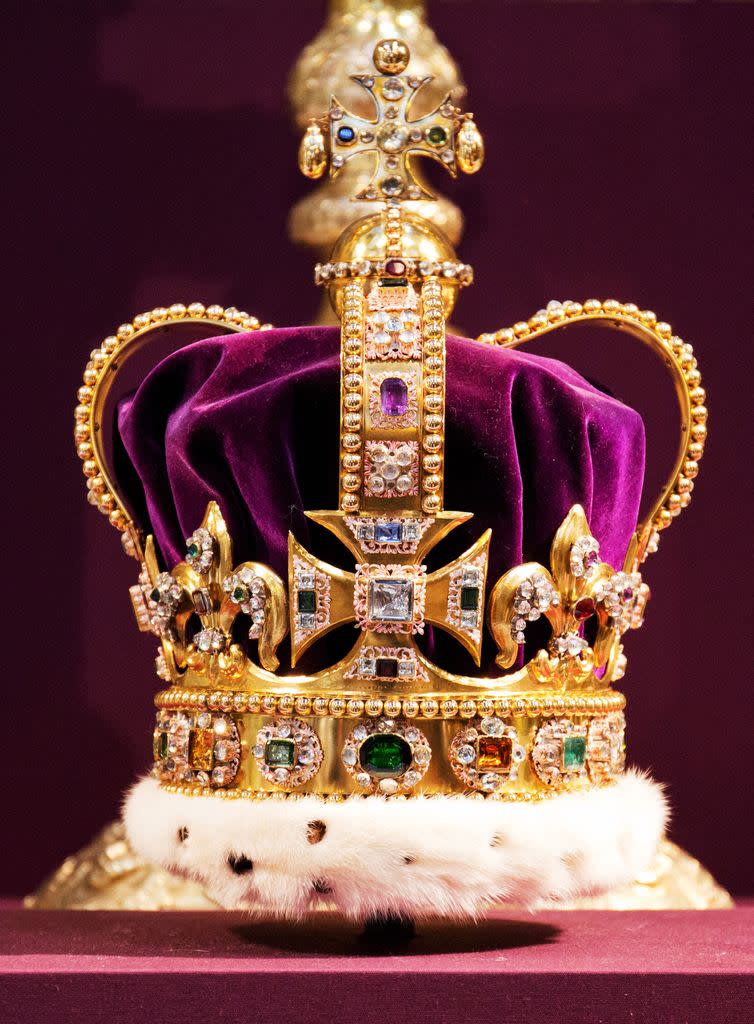
Charles will then leave the Coronation Chair and move to the throne as peers kneel before the monarch to pay homage. The Queen Consort will then be anointed in the same way and crowned.
The King will put on layer upon layer of heavy ceremonial robes throughout the ceremony – one of which he will be helped into by his eldest son, Prince William.
For the crowning, he will be given a long shimmering gold-sleeved coat to wear called the Supertunica.
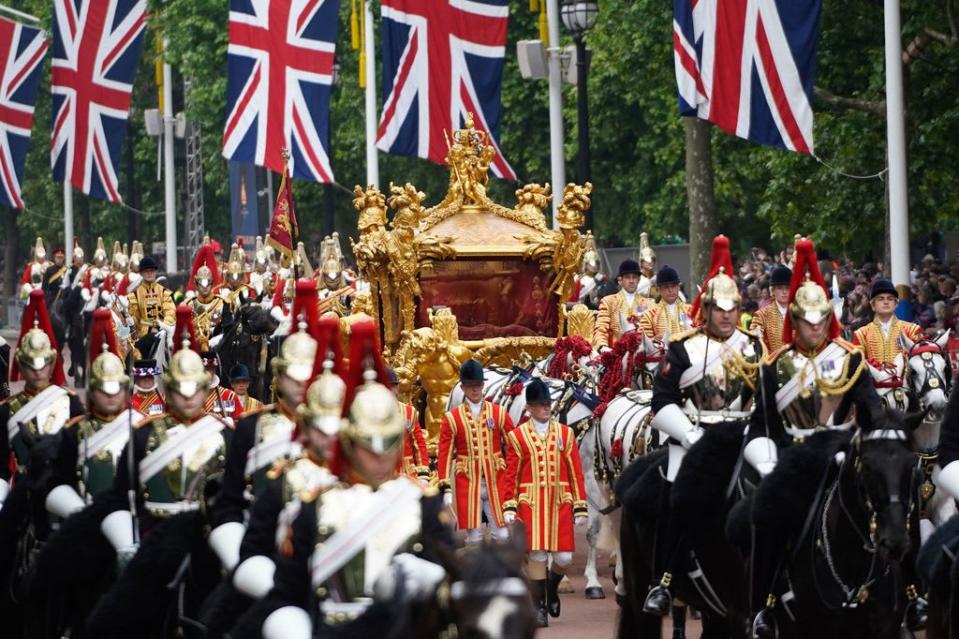
The robe was created for George V in 1911 and has been worn at successive coronations including by the late Queen Elizabeth II.
It weighs about 2kg (4.4lb), is made of cloth of gold - silk thread wrapped in thin pieces of gold or silver gilt metal - and is embroidered with stylised arabesques and floral motifs.
Layered on top of the Supertunica, there will be a floor-length cloak called the Imperial Mantle, or Robe Royal, which was made for George IV in 1821 - it weighs 3-4kg (6.6-8.8lb).
The mantle, which fastens across the chest with a golden eagle clasp, is inspired by ancient coronation ensembles and its priest-like style is meant to symbolise the divine nature of kingship.
It is tradition for recent monarchs to reuse garments, just as King Charles is, but they usually have a new coronation sword belt and glove to be used during the ceremony.
But the King has decided to reuse the belt and glove worn by his grandfather George VI - the last male monarch.
At the end of the service, the King will change into George VI's purple Robe of Estate to leave the Abbey.
Make sure you never miss a royal story! Sign up to The Royal Explainer newsletter to receive your weekly dose of royal features and other exclusive content straight to your inbox.



